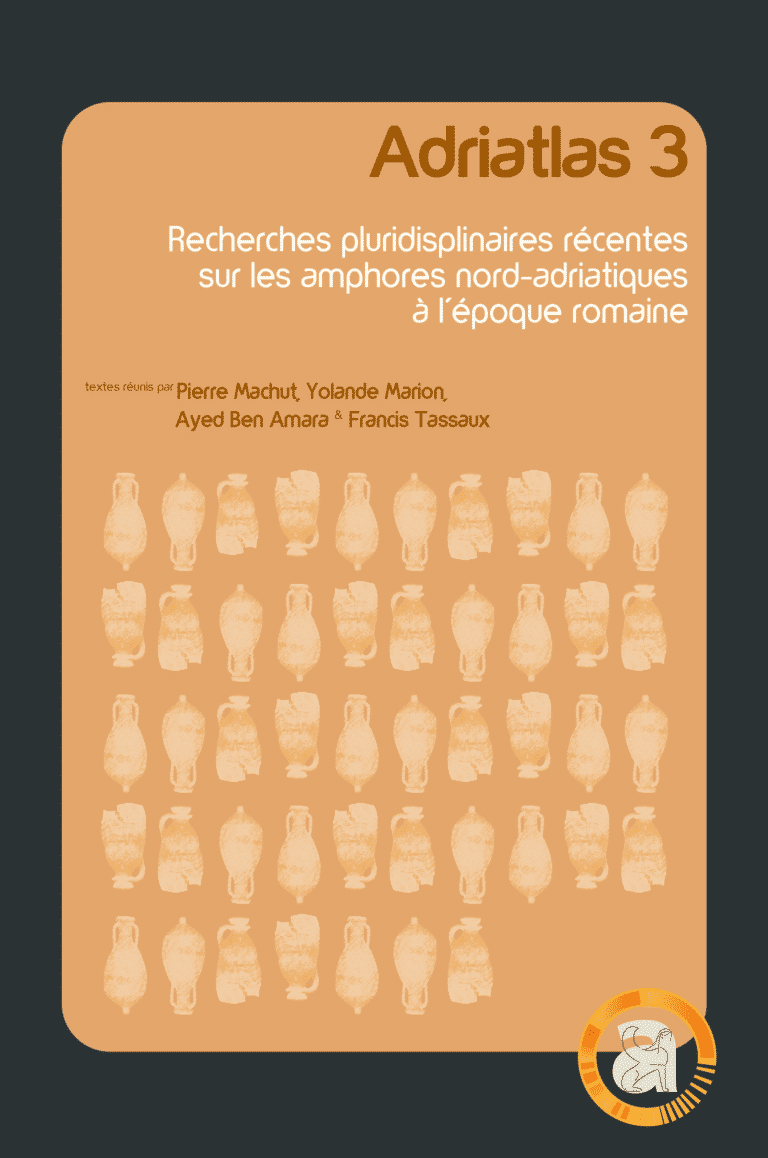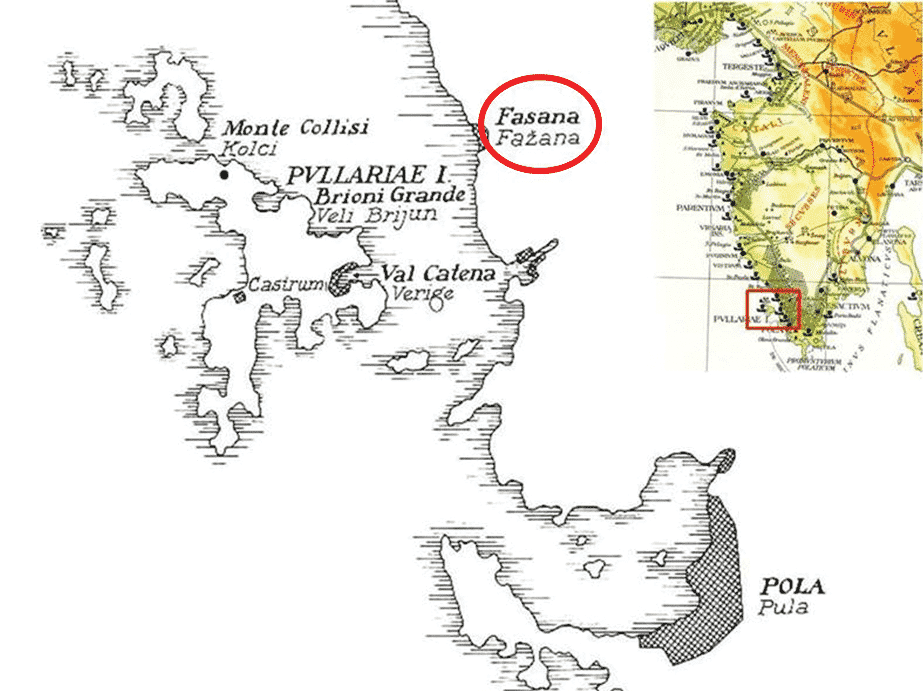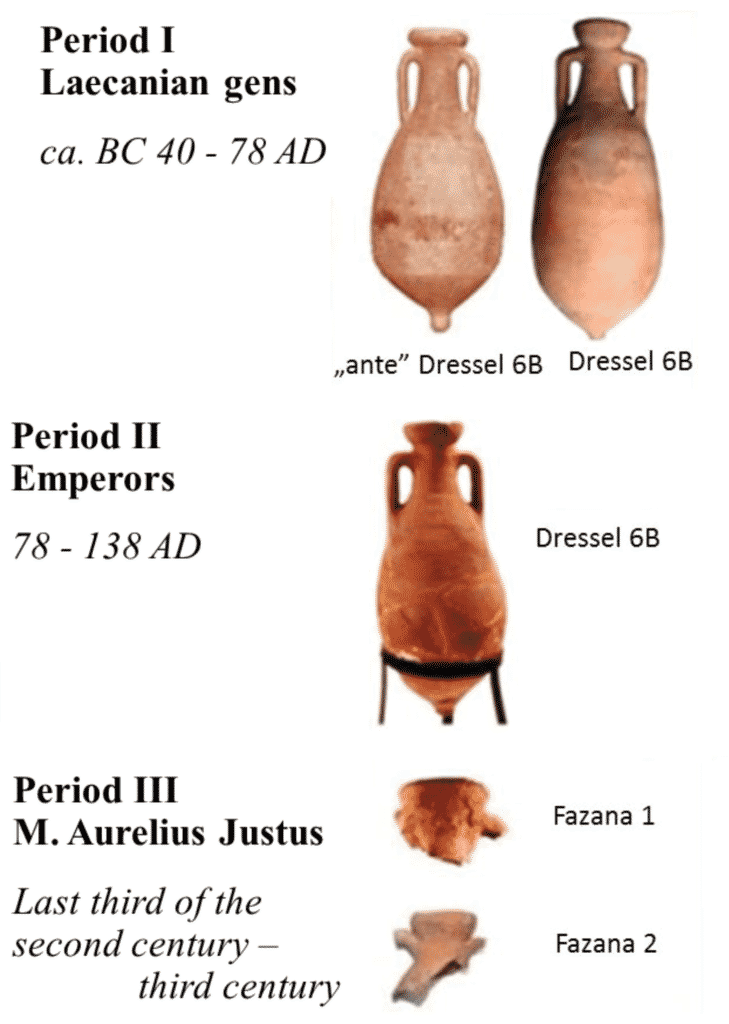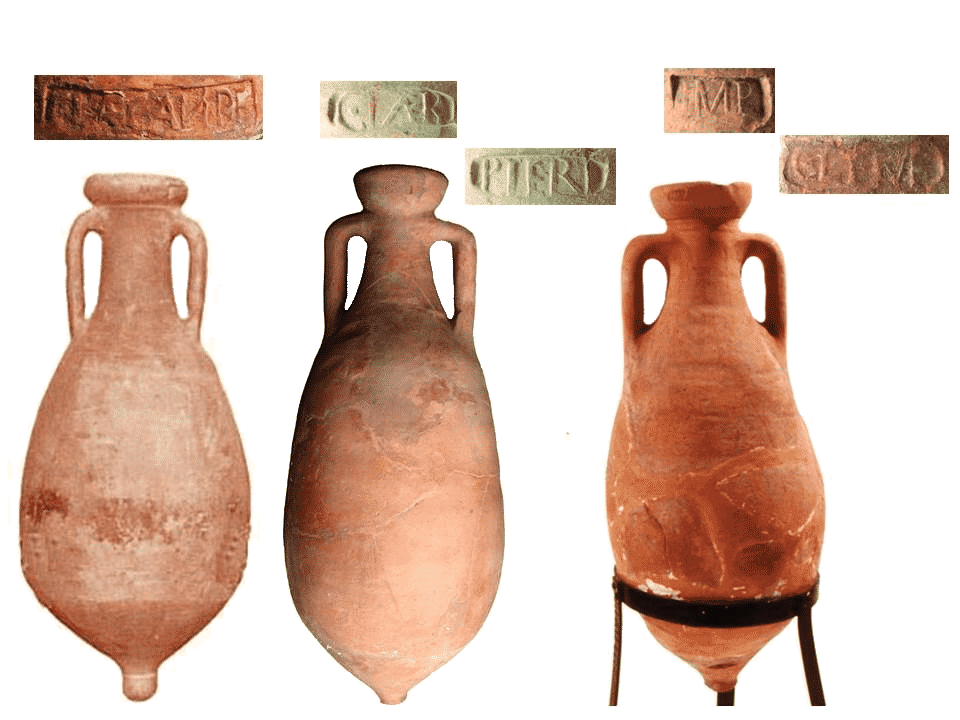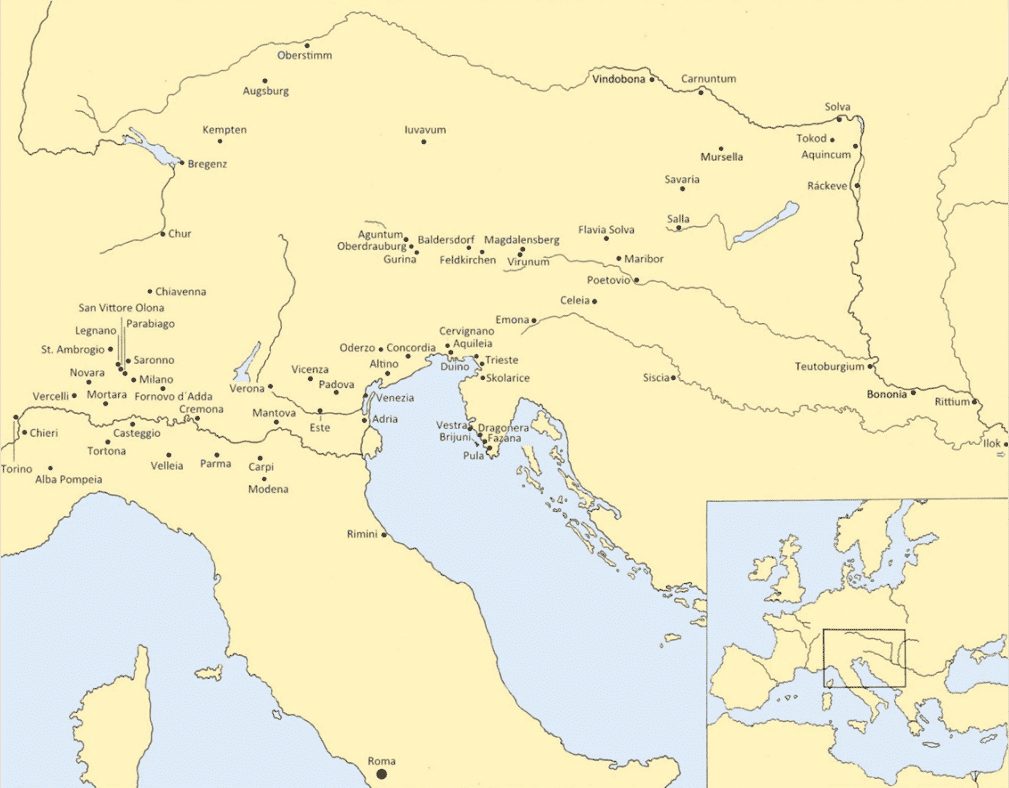From the early Roman period (Augustan to Hadrian times), Istria (North Adria, Croatia) was one of the most important sites for the production of olive oil. The oil was transported in the traditional Dressel 6B amphorae to north Italy and the provinces of Noricum, Raetia and Pannonia. The main goals of the present study were the identification of the raw material of amphorae made in Fažana in South Istria, the identification of the source rock types and the delimitation of purchasing sites of possible raw materials. During our study we observed hundreds of amphorae and field samples of possible raw materials (flysch, terra rossa and recent sediments) and applied petrographic, micromineralogic and geochemical methods. Based on our results we were able to establish that the main component of the raw material of Fažana amphorae originated from different flysch rock types occuring in North (Gray) Istria. In addition, some terra rossa and recent marine sediments could also be detected. Based primarily on petrographic arguments, it is also strongly probable that it was not flysch rock types themselves, but the shallow marine mud that was excavated from the coast of Northwest Istria from the estuary of Mirna river to Gulf of Trieste. This material consisted of large amounts of resedimented and homogenisated flysch rock debries, usually with very few terra rossa and recent marine components. After excavation, it was transported about 50-100 km by seaway to Fažana. According to the pottery experiments, this kind marine mud was suitable to produce such large potteries as the amphorae of Fažana. In certain cases some recent marine sandy material taken from the coast close to Fažana was added to this raw material as temper.
Introduction
Archaeological background
It is a well-known fact that olive oil was one of the Istrian peninsula’s most important exports for about 200 years. The ancient sources mention the excellence of Istrian olive oil1.
The Laecanius family was one of the most significant olive oil producers2. Their amphorae workshop was excavated on the territory of a modern town, Fažana, north to Pula (fig. 1)3. Eight villas on the island of Brijuni and the surrounding islands were identified. Unfortunately, it was not possible to excavate more than three villas (Verige – Val Catena, Kolci – Monte Collisi and Castrum). All of the villas, presses, cellars, dolia, and cisterns were built out of the same materials and designed similarly. Another villa 5 km north of Fažana, called Dragonera, was recently explored4. The amphora stamps suggest that the villas formed part of the Laecanius family’s properties.
There are three known phases of the workshop: from ca. 40 B.C. to A.D. 78 it belonged to the Laecanius family. During the reign of Emperor Vespasian, the last Laecanius died without an heir and the ownership was taken over by the Emperor. There are records of the workshop being used during Hadrian’s reign.
Around the last third of the second century A.D. it is presumed that M. Aurelius Iustus rented the workshop.
The workshop produced different types of amphorae: from ca. 40B.C. earliest Dressel 6B/ante 6B, then from the Augustan period the classical Dressel 6B till the Hadrian period. In the third period M. Aurelius Iustus produced the Fažana 1 (Dressel 6B 3 phase). From the late second century onwards a small amphora Fažana 2 type was also produced in the workshop (Dressel 6B 4a phase) (fig. 2).
The Fažana workshop had two stamps on the amphora rim. The owner’s stamp (Laecanii and Emperors) is in the middle and the second stamp (that of the vilicus or workshop manager) is above the handle (fig. 3). Before the death of Laecanius, we know of 4 workshop manager stamps (Clymenus, Datius, Paganus, Ptolemaeus). These stamps also co-occur with the stamp of the Emperor Vespasian. The fact that the estate was taken over by the Emperors can be established from the evidence the stamping system offers.
The olive oil produced in the Bijuni villas and in Fažana was of immense importance in Cisalpina and in the northern provinces of the Roman Empire (Noricum, Pannonia and Raetia). Olive oil was consumed by the Roman army and Roman settlers (fig. 4).
A new situation arose when Istrian oil production ceased after the Hadrian period. The characteristic Dressel 6B amphorae disappeared from the traditional markets when Istrian oil production decreased to a minimum. Merchants filled the gap with imported oil from Hispania Baetica, transported in Dressel 20 and African amphorae. They supplied all of the markets (Cisalpina Gallia, Noricum, Pannonia) which were formerly supplied by Istrian oil.
The capacity of one amphora had to be about 37.9 – 39 litres (12 congii = 39.3 litres). The quantity of olive oil and the amount of amphorae can be determined from the dolia in the basement of the villas. One dolium has a capacity of 1 750 litres. The villas on the island produced a maximum of about 3 500 hectolitres of olive oil per annum, plus an unknown amount of Fažana and Dragonera. Around 9 000 amphorae would have been needed for transport. This is, of course, a rough estimate.
There is an inscription from the period of Claudius that documents the property of the senator Laecanius pater (CIL, V, 698 = ILS 5889 = InscrIt, X, 4, 376). Senator Caius Laecanius Bassus was praetor urbanus in A.D. 32 and consul suffectus in A.D. 40. The fragment of the sodales augustales claudiales mentions him as pater in the year 64. The same inscription mentions a property in northern Istria at Materija next to the Rundictes tribe (today part of Slovenia).
There are two inscriptions near Vodnjan (Dignano) which mentioned C. Laecanius Ialysus (CIL, V, 14 = InscrIt, X, 1, 630) and C. Laecanius Amycus5. These names occur on a number of amphora stamps. There is another inscription C. Laecanius Menander, who was perhaps the secretary of both the senators. (CIL, V, 8142 = InscrIt, X, 1, 114).
Previous archeometric works
The archaeometric research of the Dressel 6B amphorae manufactured in Fažana have started more than 30 years ago. Firstly quantitative and qualitative description of about 200 thin sections of amphorae were made. The first petrographic classification of amphorae was based on the texture and nonplastic components6. In addition, some samples were measured by XRD for coarse evaluation of the firing temperature7. Afterwards, to compare the nonplastic components of Fažana amphorae with the components of the terra rossa, a detailed micromineralogical analysis of the loess and the skeletons of recent marine life from the Istrian peninsula was performed. At the same time 300 new thin sections of amphorae were petrographically evaluated and a new classification was created based on the previous and new results8.
The main results of the above mentioned researches are summarised as follows:
- Nine petrographic groups were determined based on the fabric analysis.
- The loess containing terra rossa from Istria was assumed to be the main component of the raw material of Fažana amphorae.
- The presence of skeletal fragments of marine life in amphorae was also proved.
- The heavy mineral composition of the amphorae samples and the loess containing terra rossa were found to be partly different. The origin of distinct parts of heavy minerals in the amphorae remains unknown.
- The firing temperature was roughly estimated in the range of 750-900oC.
Aim of the work
The main goal of this study was to obtain more exact knowledge about the manufacturing process of Fažana amphora from raw material exploration to throwing of amphora body . We believed that we could get closer to the answer to this question if we paid special attention on raw material determination. The effect of firing was examined only in order to recognise more reliably the components of different raw materials used for amphora production. To this end, we have drawn three main questions.
- What raw materials were used;
- Where were the raw materials taken from;
- How were the raw materials prepared for throwing.
We would like to know in detail:
- The exact nonplastic composition of Fažana amphorae;
- What kind and how many types of raw materials yielded these components;
- Whether these raw materials could be found in the surroundings of Fažana;
- In what proportions these rock types occur in the amphorae;
- What could be the exact composition of excavated raw materials;
- Were other additives used in the final composition of raw material mixture.
To answer these questions, we first made very detailed petrographic (optical and electron-microscopic) research not only of the amphorae but of all possible raw materials occurring in Istrian peninsula. To supplement and verify these results micromineralogical and geochemical investigations were also carried out.
If we can answer these questions, we will have more ideas about the level of technological knowledge of roman people in connection with geological materials and pottery manufacturing. Furthermore we would obtain more information about the activities of the Laecanian lordship connected with amphora production.
Methods
During our research we used four main methods:
- Geological field work,
- Petrography,
- Micromineralogy,
- Geochemistry.
In order to achieve more accurate and reliable results, we established a new research strategy which is described step by step as follows:
- A detailed macroscopic description and grouping of all amphora samples was performed9. This classification does not necessarily reflect the original compositional differences, therefore later on it may be modified on the basis of detailed petrographic descriptions.
- On representative amphorae, samples of macroscopic groups simplified thin section petrography of Fažana amphorae were taken. With this step, the relatively common ingredients of amphorae made in Fažana workshop could be recognised, which is important for searching the possible source raw materials.
- A field geological search and extensive analysis of different typical rock and sediment formations was done in the closer and wider surroundings of Fažana (namely in Istria). We visited more than 70 localities and collected well over a hundred rock samples (flysch, terra rossa and recent sediments). During sampling, we preferred materials which might contain materials found in amphorae and/or seemed to be suitable for pottery production. Next, we tried to find possible deposits of raw materials, which were suitable for larger-scale excavation and from where the raw material could easily be shipped.
- A detailed petrographic (polarizing microscopic) study of all collected field rock samples which cover all main possible raw materials (including fired clayey varieties) as well as of possible source areas (in our case in the Istrian peninsula and surroundings) have been made.
- A detailed petrographic (polarizing microscopic) study was made of all available amphorae samples bearing the two different stamps uniquely characteristic of Laecanian amphora workshop in Fažana. Approximately 500 earlier made and around 300 newly made thin sections of amphorae were examined. Detailed study of such a large number of samples is strongly justified because of the rarity and the small size of many significant components.
- A detailed comparative petrographic evaluation of amphora and raw material samples selected on the base of their significant component content and/or texture. In this stage of study we tried to determine the exact origin of each characteristic component of Fažana amphorae and the material of the amphora as a whole. A polarizing microscope was used to determine nonplastic components and texture, and an electron-microscope was used to determine accessory minerals and to comparatively observe the microtextural features of the plastic material of amphorae and fired clayey raw materials.
- A comparative heavy mineral analysis of amphorae and the two main supposed raw materials (terra rossa and Istrian flysch), using stereo-, polarising- and electron-microscopy (SEM-EDX). Moreover a RAMAN spectroscopy was also carried out. Based on qualitative and quantitative heavy mineral data, identification of the raw materials of Fažana amphorae and an estimation of their mixing ratio was possible.
- A chemical analysis (X-ray fluorescence – XRF) was also performed to determine the geochemical features of the two main possible source materials (terra rossa and Istrian flysch) and to make a geochemical comparison with Fažana amphorae.
Analytical data
From each soft rock or sediment sample (e.g. terra rossa, clays and micrites from flysch, recent river and marine sediments), two bricks (2 x 3 x 6 cm) were prepared for thin sections. One had been prepared only by drying, the other – after drying – by firing at a maximum temperature of approximately 750oC for one hour. For polarizing microscopic study, normal sized (2,5 x 4,8 cm) covered thin sections were made. For electron-microscopic study small sized (2,5 x 2,5 cm) polished thin sections were made. For petrographic descriptions, a Nikon OPTIPHOT2-POL polarizing microscope was used. Pictures were taken with a Nikon DS Fi1 camera and adjusted by NIS Elemens program. Test bricks were fired in the electric kiln of the former National Heritage Center of the Hungarian National Museum. Detailed description of the micromineralogical investigations can be seen in Obbágy et al. 2014. SEM-EDX measurements were made in the Department of Petrology and Geochemistry on a AMRAY 1830i type scanning electron microscope equipped with an EDAX PV 9800 Energy Dispersive Spectrometer. Measurements were taken under 20 kV accelerating voltage and 1nA beam current conditions. Chemical analyses were made in the Department of Geology and Isotope Geochemistry in University of Tübingen by Bruker AXS S4 Pioneer type XRF instrument.
Results
Petrography
During our petrographic study we investigated all available Fažana Dr 6B amphorae found in the entire oil distribution area which had two stamps (owner and villicus) the age of which have been determined in detail by Tamás Bezeczky10.
Macroscopic petrography of amphorae
Macroscopically, the Dressel 6B amphorae are typically light red, red or reddish yellow, while some subgroups have a pink or yellow color. They are very large and fine-grained with weak or no orientation. The non-plastics are not, or only very rarely, visible by the naked eye. They look mostly compact with variable porosity, and the pores are extremely fine. A further detailed macroscopic description is given by Mange and Bezeczky (2007).
Brief polarizing microscopic petrography of amphorae
The main raw material of the amphorae, like those of many other fired potteries, is a mash of originally soft clayey material (plastic component) and mostly rock-originated hard grains (nonplastic material), which is hardened by firing. The plastic material, which usually comprises more than 70 % of the entirety of raw material, consists of submicroscopic material and thus it is not possible to determine its exact composition by polarising microscope. Accordingly, the main subjects of our micropetrographic study are the nonplastic components of the Fažana amphorae. Because of this, an electron-microscope was used for adequate description of fine-grained groundmass materials.
Brief micropetrographic description of amphorae
Under polarizing microscope the matrix (plastic component) is mainly reddish brown, rarely yellow, with usually weakly oriented clay mineral. The clay groundmass shows strong porosity with equidimensional very small-sized pores (fig. 5). The non-plastics are generally well sorted, the grain size is usually less than 100 µm, except of some much larger sized limestone and other rock fragments or bioclastic materials (e.g. fossils). The non-calcareous rock fragments are generally scarce (max. 10 %, occasionally more), while the limestone fragments occur in variable proportions, from none 0 to approximately 30 % of the total aplastic compoment of the fabric (fig. 6).
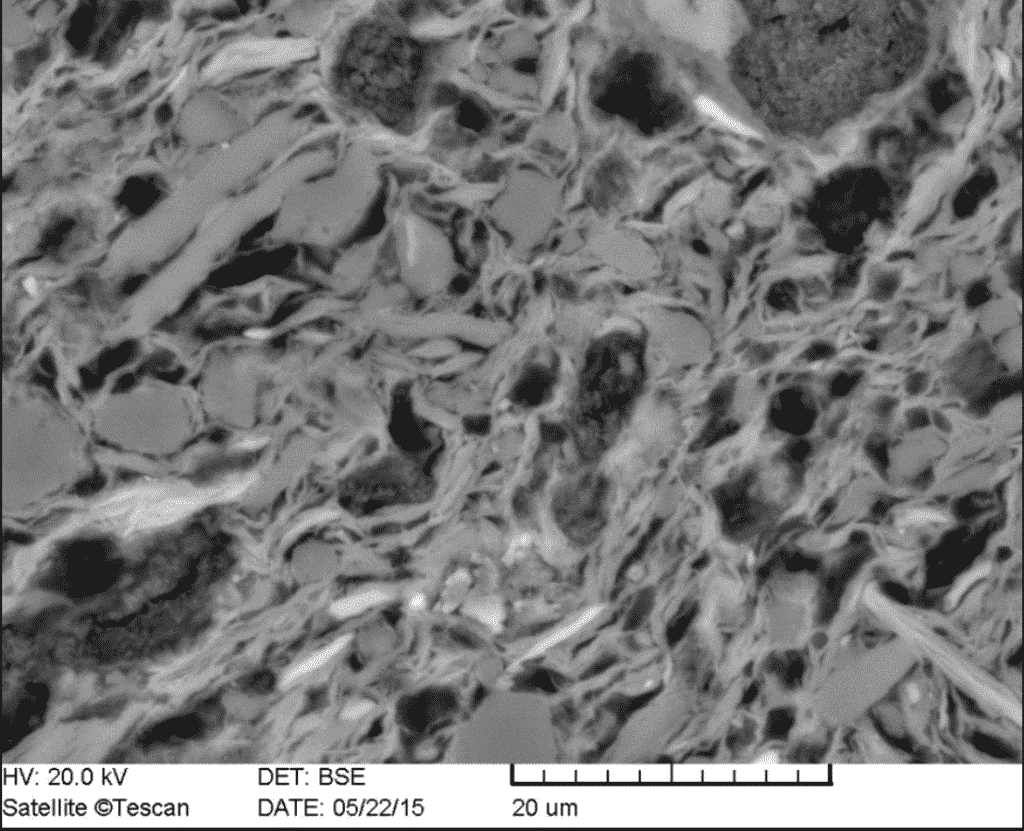
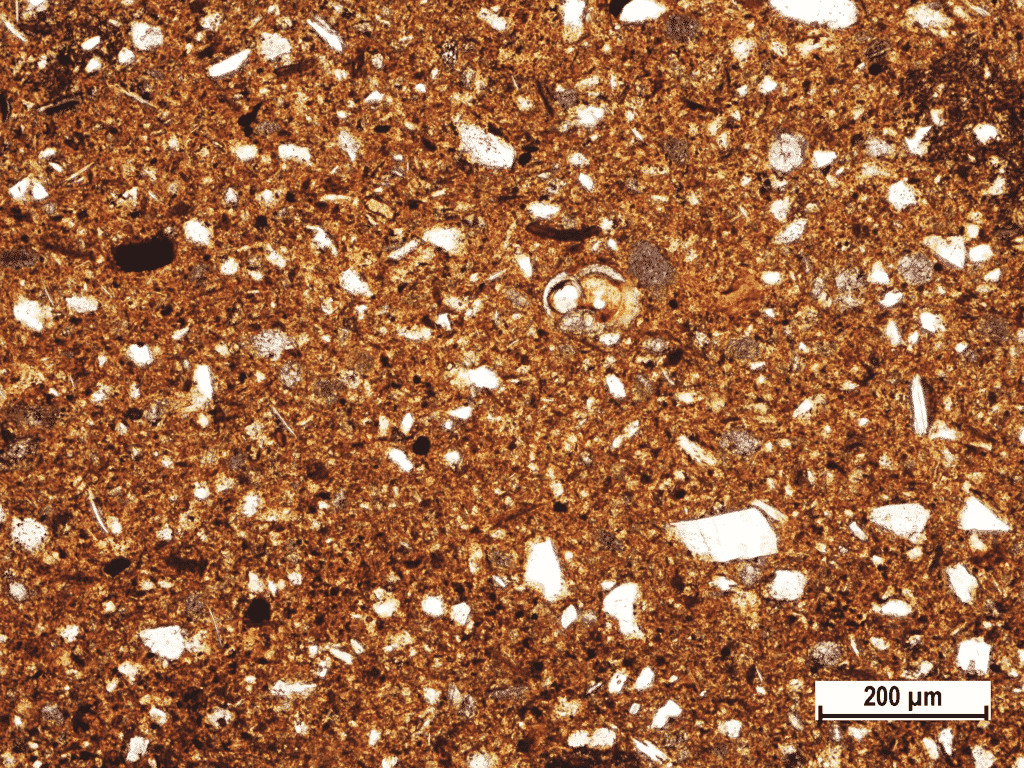
The dominant non-plastic component is quartz (mainly angular, monocrystalline, with undulose extinction). Only a small amount of polycrystalline quartz and feldspars (orthoclase, plagioclase, microcline) occur. Small siliciclastic rock fragments (mainly chert, acid volcanic rocks and crystalline rock fragments) are rare. Micas (mostly muscovite) can be found, usually in small amounts. Accessory minerals (most frequently hornblende, garnet, tourmaline, epidote, zoisite and very few Cr-spinel) are rare and fine-grained. Calcareous rock and mineral fragments (micrite and sparite) appear in variable form and quantity, while calcareous (most frequently globigerinoida, less frequently other foraminifera and mollusca) and siliceous (more opalic – acicular and spheric – and less chalcedonic sponge spiculae) bioclasts are very distinctive. Larger, mostly rounded sedimentary rock (sandstone, siltstone, claystone, limestone) and calcareous biogene skeleton fragments (rarely with traces of bioerosion) are also very significant but could be found only in a few amphora samples (fig. 7).
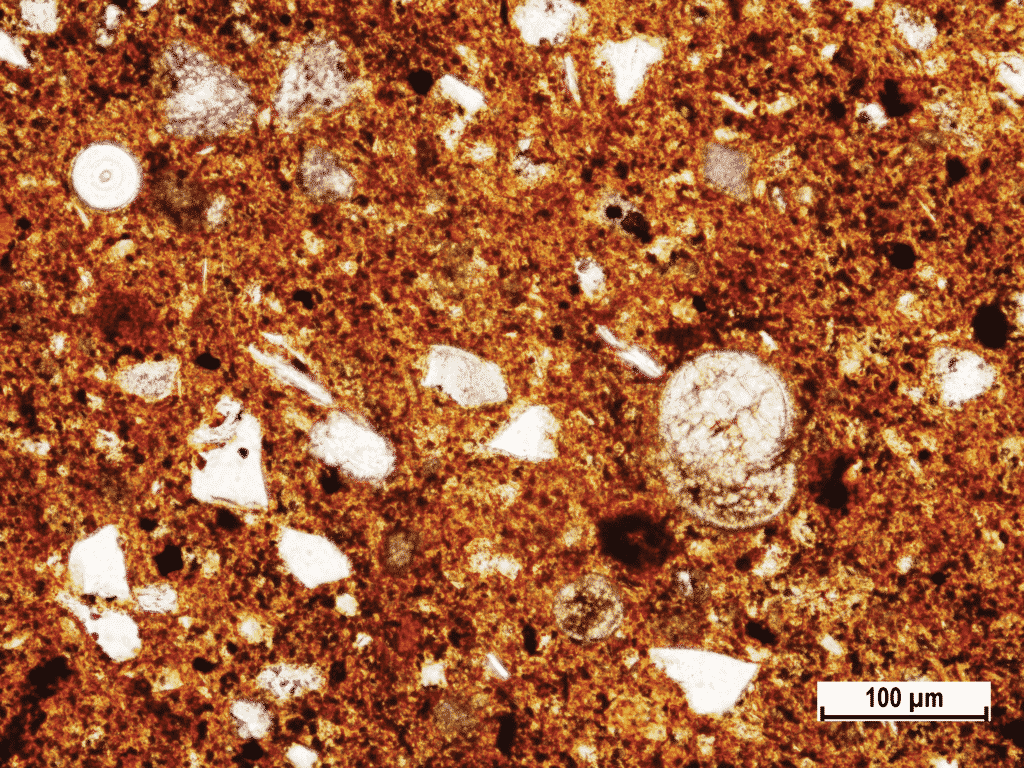
Brief description of potential raw materials
According to our research strategy on identification of possible raw materials we began with geological literary and field work, using geological maps, field guides and rock descriptions. After the collection of samples from 70 localities, detailed micropetrographic investigation could begin (fig. 8).
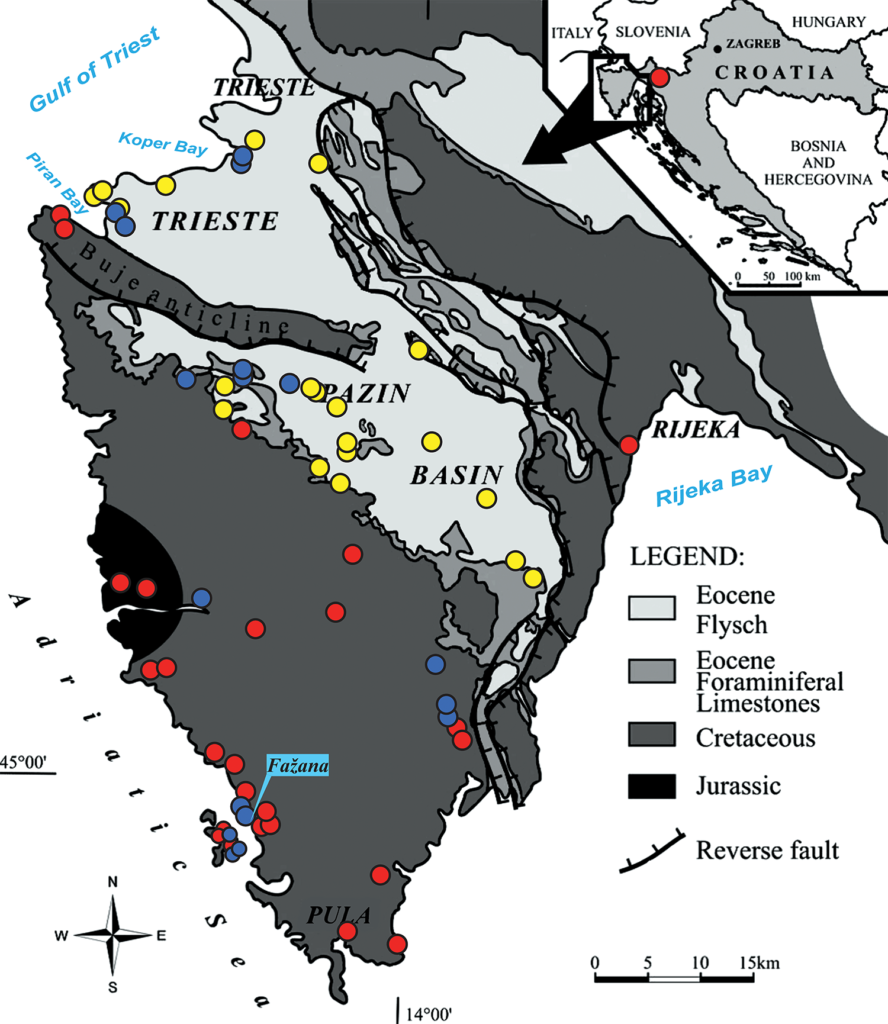
Red spots:terra rossa (TR), yellow spots: flysch (FL), blue spots: recent sediment (RS)).
Field observations
On the surface of Istria three main groups of rock appear.
- Flysch is a name of a sedimentary rock series which is formed in deep marine environments and usually consists of both calcareous, siliciclastic and clayey rock varieties, alternating with each other even in the same outcrop. Flysch of Cenozoic age appears only in the northern part of Istria (Gray Istria). All rock varieties of Istrian flysch are finegrained and homogeneous, having for the most part a grayish or yellowish colour, and except for pure, hard, more crystalline limestone varieties they are weathered easily resulting in soft fine-grained sediment. This weathered, eroded and redeposited flysch material appears in huge amounts in debries fans, fluvial and shallow marine coastal muddy sediments in North Istria (fig. 9, 10).
- The shallow marine Mesozoic limestones are for the most part white-coloured compact hard rocks and appear mainly in South Istria (Red Istria), as well as sporadically in Northwestern Istria.
- Terra rossa is a very dense pore-free homogenous dark red clayey rock type. It often contains a few large (mostly 0.1-2 cm) fragments of underlying limestones, as its genesis in the Mediterran region is closely linked to these rock types. For the same reason it appears as a sedimentary (from a few centimeters to more than ten meters thick) cover on Pre-Pleistocene karstic surface of mostly Mesozoic limestones, primarily in South Istria (Red Istria), so its surfacial distribution is the same as that of the Mesozoic limestones described above (fig. 11).
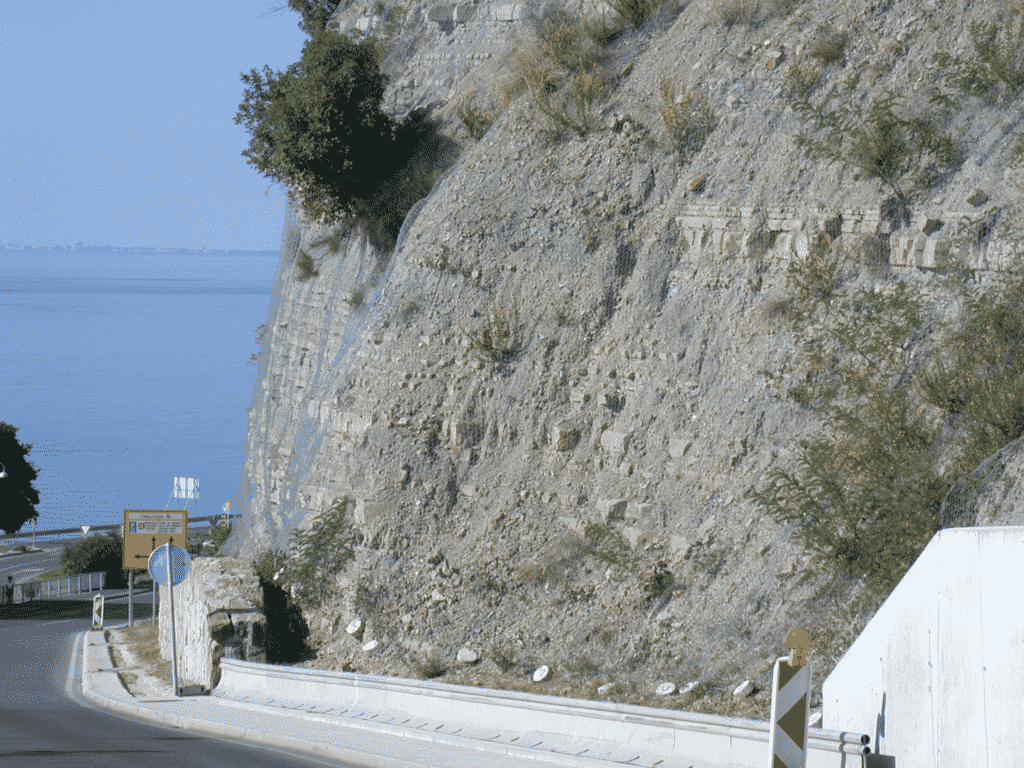
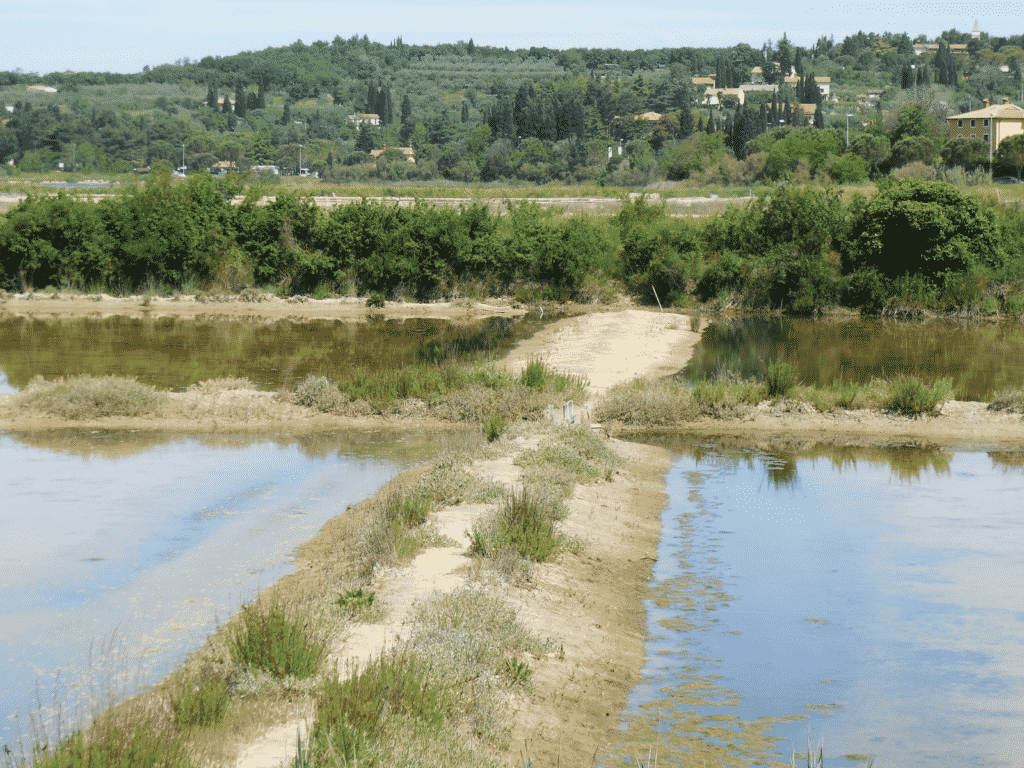
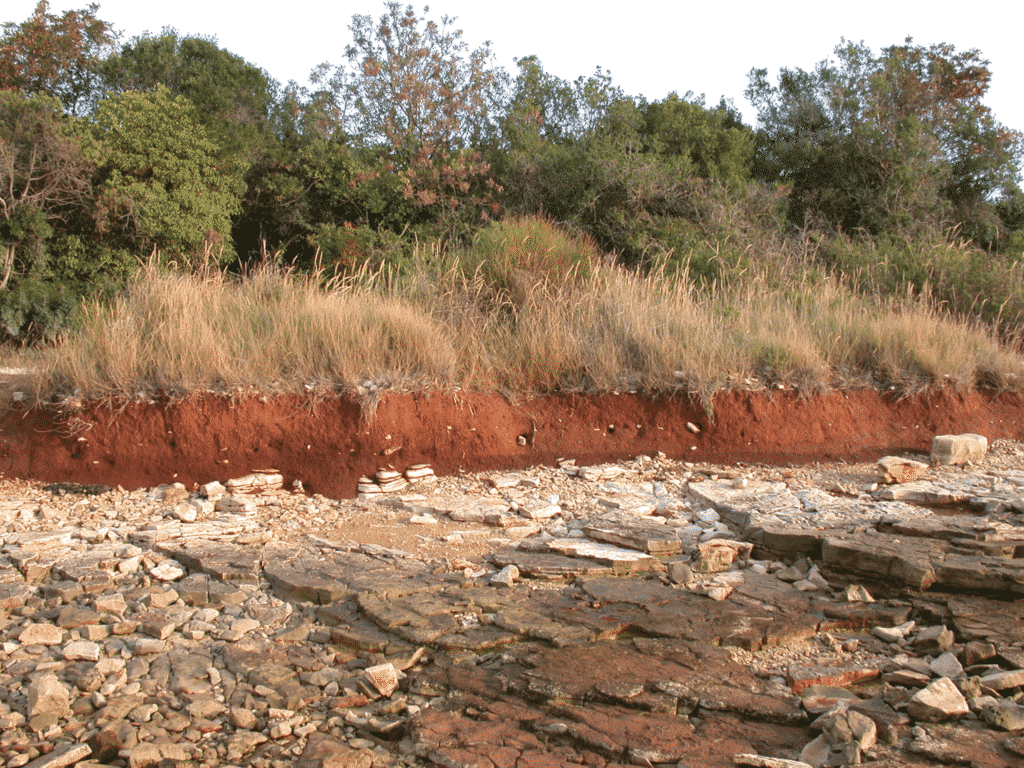
After erosion and redeposition small grains of limestones and less terra rossa appear mostly in coarse-grained sandy coastal sediments of South Istria.
In addition to the above-listed field rock types, recent marine originated living being skeletal remnants are also worth mentioning as a possible raw material. These fragments appear in large amounts in the sandy material of the rocky coasts of South Istria and in very small amounts in coastal muddy sediments in North Istria.
During geological field work, all of the above-mentioned materials were collected, but we paid particular attention to those rock types which seemed to be suitable as pottery raw material.
Brief micropetrography of potential raw materials
Flysch (FL)
Under a polarising microscope the three main flysch rock types have different textures, but similar components in different proportions. Siliciclastic material, which appear in sandstones and siltstones is angular medium sorted with 40-200 µm grainsize. It consists for the most part of large amounts of monocrystalline quartz grains with undulatory extinction, more micas, few feldspars and usually very few accessories. Some characteristic components (microcrystalline quartz rock fragments – magmatic and cherty origin –, Cr-spinel, chalcedony sponge spicula) could also be recognised in small amount. In the sandstones and siltstones, beside siliciclastic material, calcareous grains (sparites, micrites and fossils) with similar size and shape also appear in variable but frequently considerable amount.
In the very fine-grained flysch rock varieties (micritic limestone and claystone) the matrix consists of micrite and/or clay in extremely varied proportions.
In both flysch rock types calcareous fossils, more foraminifera and, more rarely, molluscs occur in varied amounts. Among them the most characteristic type is the globigerinida foraminifera, which appear both in thick shelled and thin shelled form filled with microsparite and in opaque mineral filled form as well (fig. 12, 13).
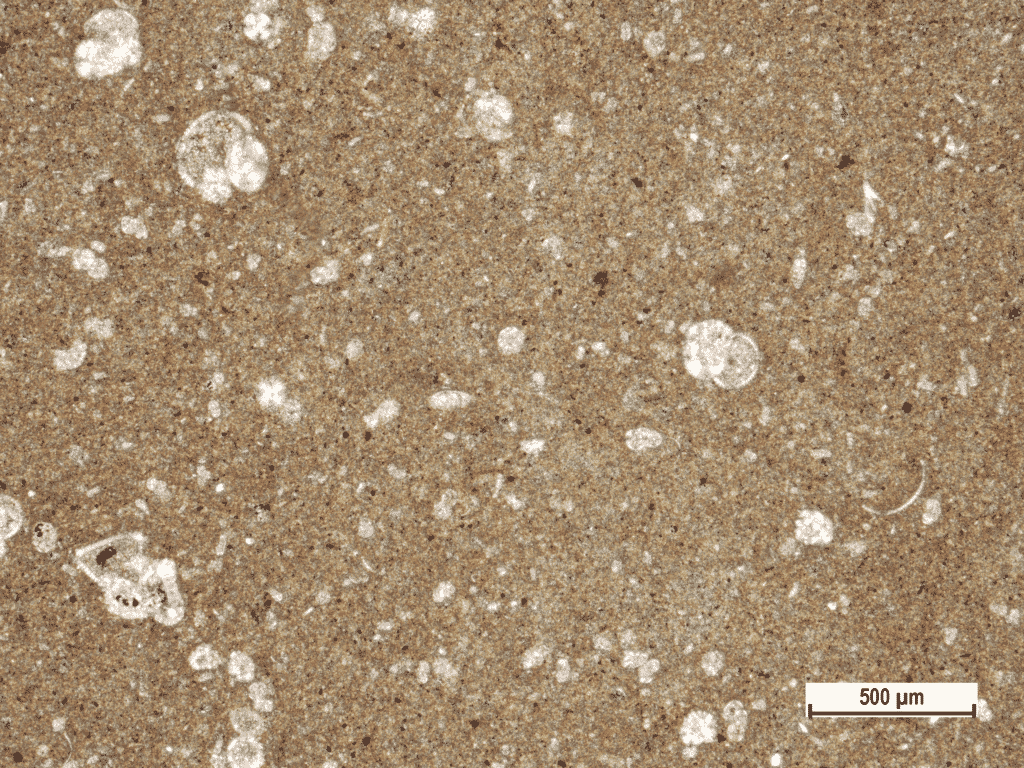
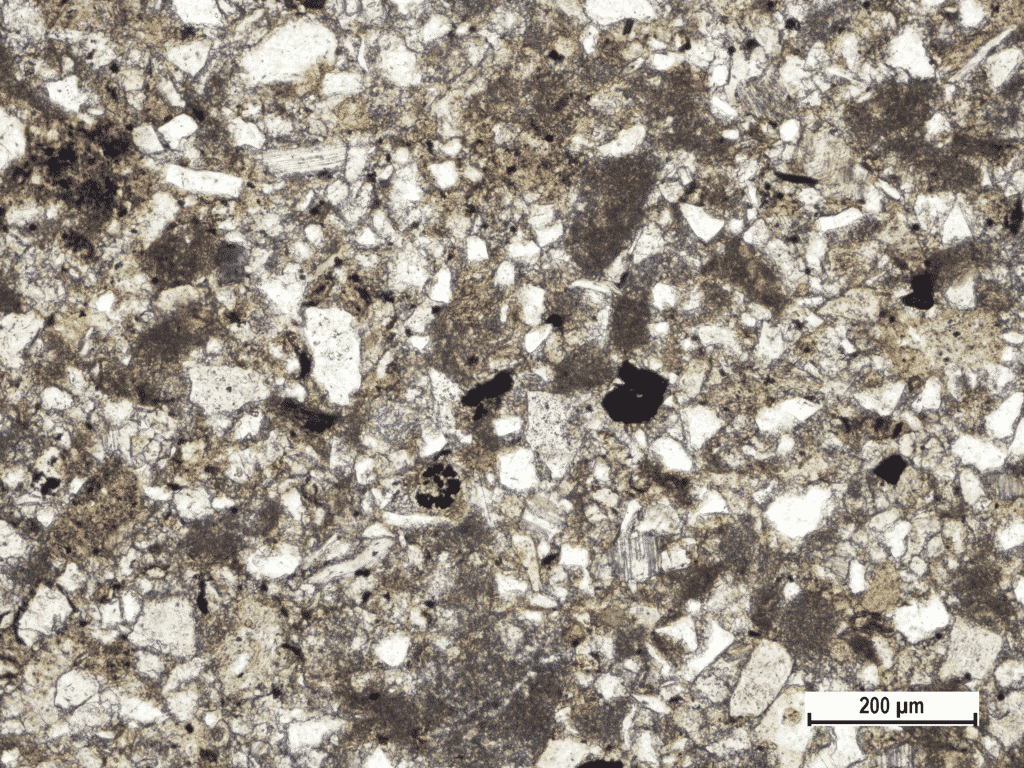
Mesozoic limestone (ML)
In polarizing microscope Mesozoic limestones consist of some micrite and more microsparite and sparite in heterogeneous distribution. Sparitic veinlets and sparite filled fossils are common.
Terra rossa (TR)
Under a polarising microscope two types of terra rossa could be distinguished. The so-called pure terra rossa is a homogeneous clay (with submicroscopic grains size) with a very characteristic bright red color, often with a visible, slightly irregular striped structure. There is not any clastic material in it. Its microtexture, which has formed after firing, is easily visible under an electronic microscope and has a dense, poreless feature with lots of small accessory minerals in it (fig. 14). The so-called mixed terra rossa or terra rossa soil consists of a clayey matrix, which looks similar under both the polarizing and electron microscope to the material of pure terra rossa. In addition, a large amount of fine-grained siliclastic material exists in the groundmass (from 40 until 80 µm grain size), it is well-sorted and consists dominantly of quartz with undulatory extinction and considerable amounts of accessories. Feldspars and micas are rare. Calcareous components (except large underlying Mesozoic limestone grains) or any fossil fragments are entirely missing from both types of terra rossa (fig. 15).
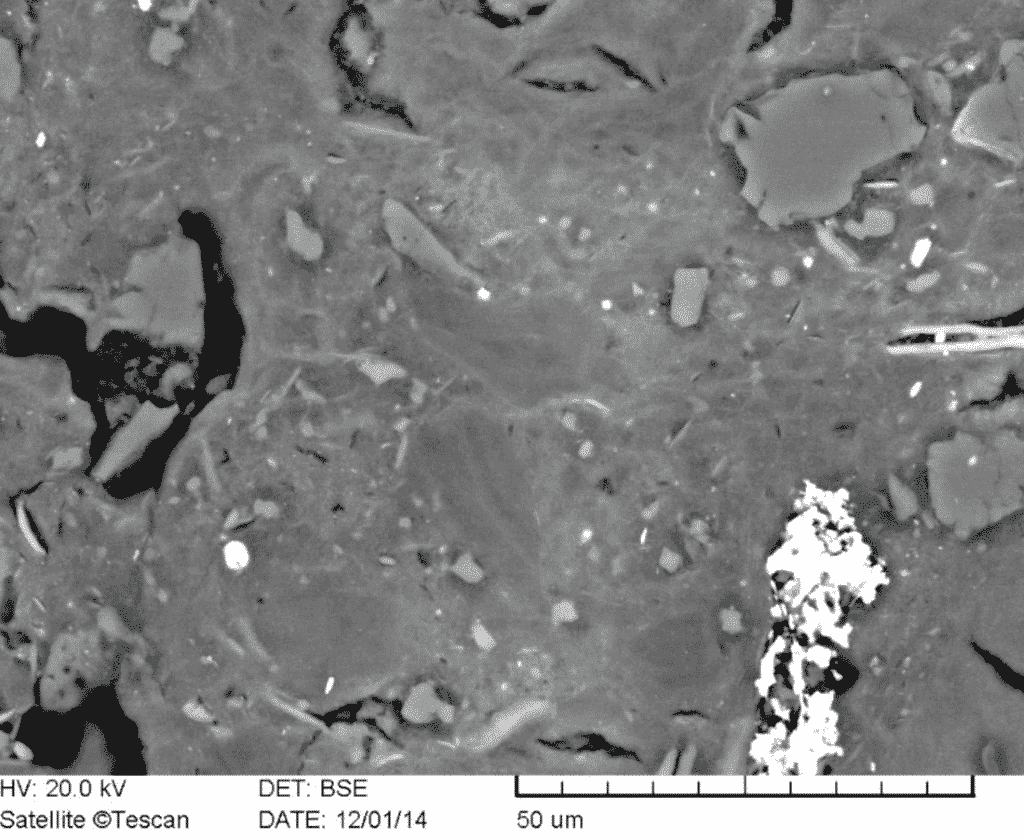
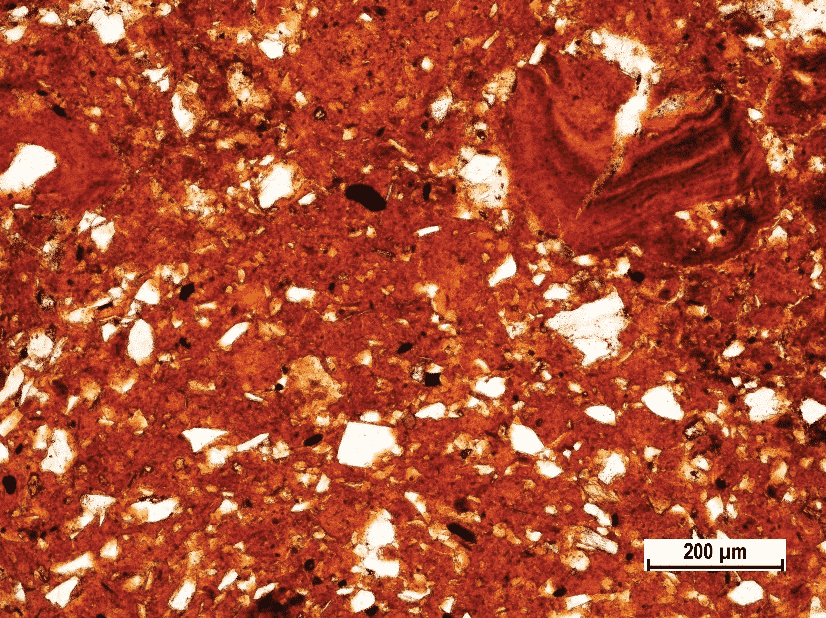
Mixed terra rossa is widespread in all Istria, but pure terra rossa appears mostly in northern and northeastern parts of Istria as well as in inland territories while it is rare in South Istria.
Recent sediments (RS)
Recently or subrecently redeposited rocks or sediments discussed above were also collected and studied by polarizing microscope. In North Istrian flysch debries cones (RDS) and recent fluvial sediments (RFS) consist of mixture of flysch rock grains and comparatively fewer clayey matrix. Recent shallow marine sediments (RMS) appear in two main different situations.
The muddy samples (RMmS), collected from the flat coasts of the bays in Northwestern Istria consist dominantly of flysch-originated, very fine-grained homogeneous muddy material (fig. 16). It contains only few calcareous flysch originated fossils, even less thin and elongated recent ostracoda shells and very rarely recent opalic sponge spiculae. Moreover, some terra rossa
grains could also be identified in the samples. The microtexture of fired test specimens made of this marine mud samples showed strong microporosity formed of small isometric pores of equal size (fig. 17).
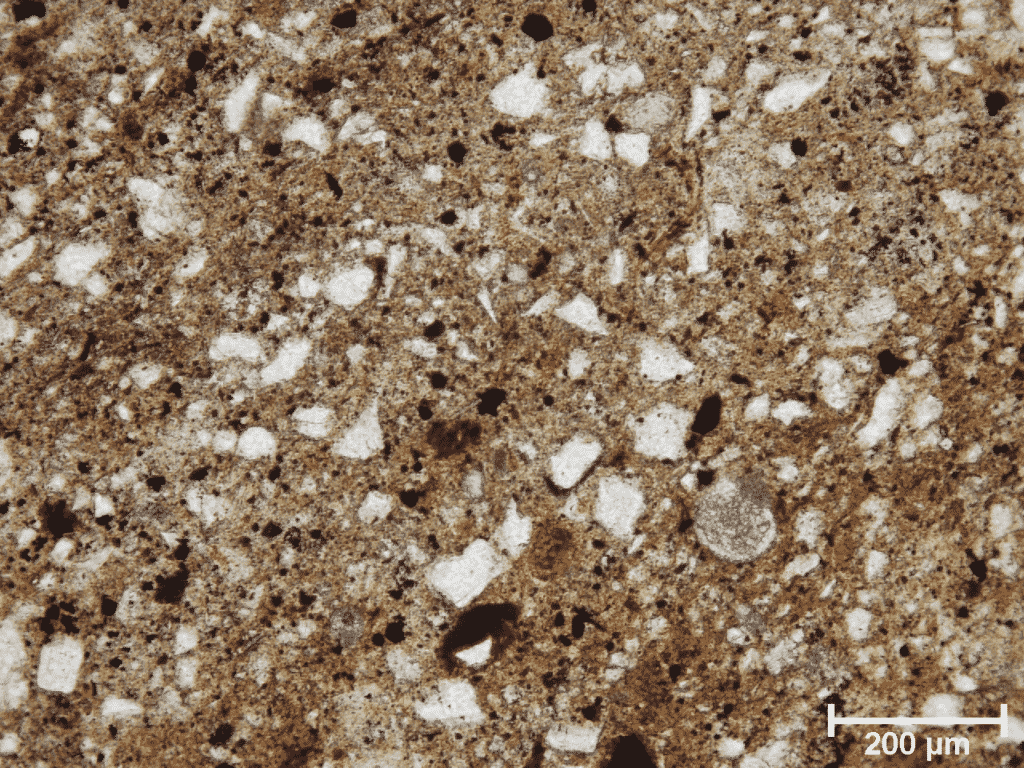
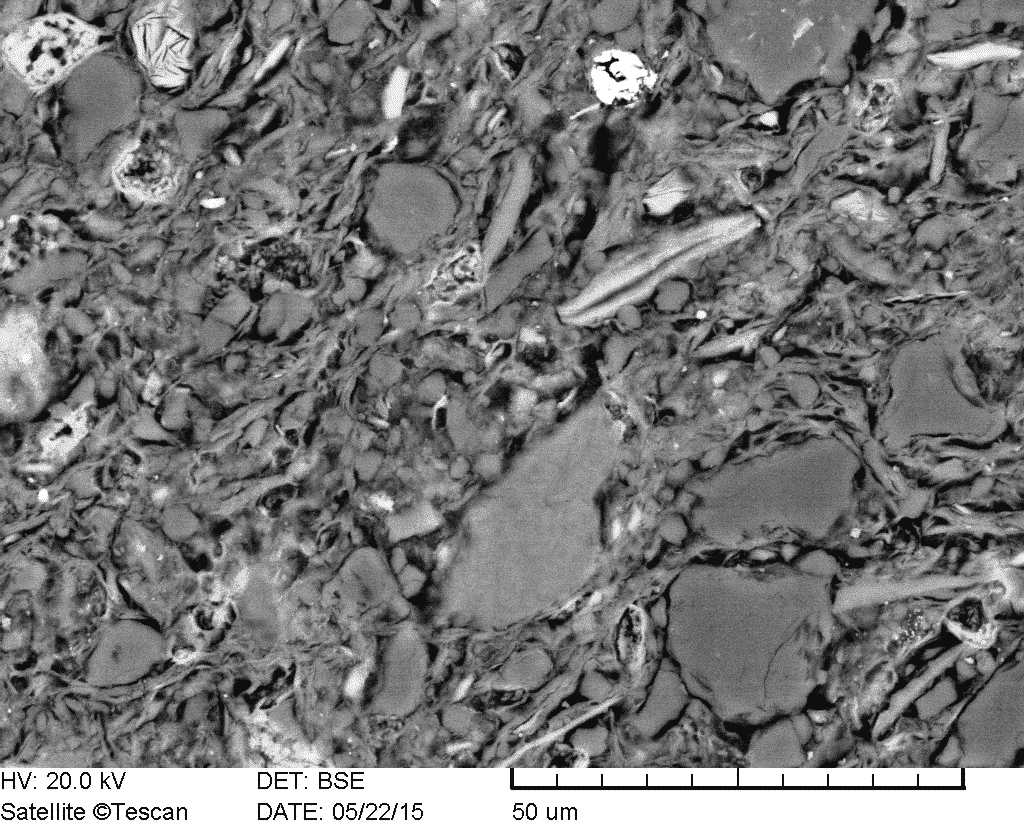
The sandy mud marine samples (RMsS) collected from the rocky coast of South Istria contain large amount of coarse grained calcareous skeleton fragments of recent marine living beings (in some cases with traces of bioerosion) and small amounts of recent opalic sponge spiculae (fig. 18). Coarse-grained mineral (quartz) and rock fragments (Mesozoic limestone and terra rossa) eroded from inland areas of South Istria are also present in these samples.
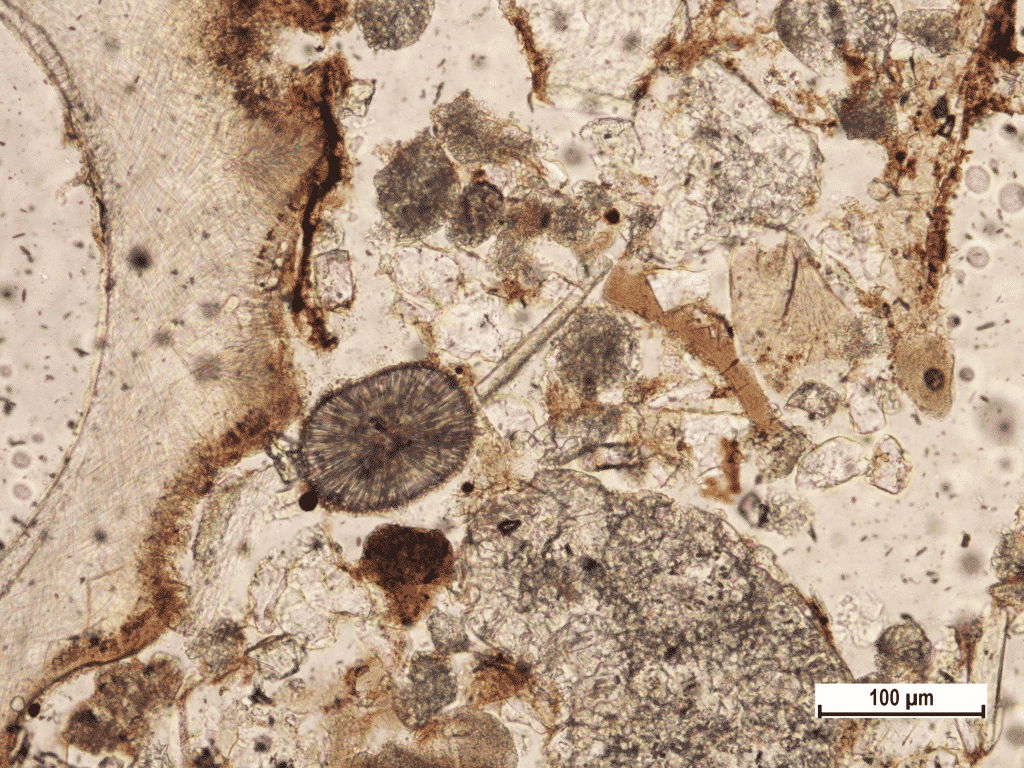
Detailed comparative petrographic evaluation
In the first stage of our comparative petrographic evaluation we were looking for such characteristic components and textural features in Fažana amphorae which showed clear similarities with or differences from the components and textures observed in investigated potential raw materials. As shown above, the nonplastic components of amphorae could be easily recognized and identified even by petrographic microscope. Moreover, they could be well matched to the components of potential raw materials. However, the comparison of the microtexture of fine-grained matrixes under electron microscope was also successful. In this paragraph the result of the comparative petrographic evaluation will be presented according to the components found in Fažana amphorae and in both potential raw materials: the flysch (FL), the terra rossa (TR), the Mesozoic limestone (ML) and the recent marine originated components (RM).
- The reddish brown color of the groundmass of amphorae differs from the bright red color of the groundmass of fired TR, and more similar to the color of fired clay rich varieties of FL rock types.
- The amount of nonplastics in the amphorae is generally much lower than that of the TR and in most cases it is close to the amount found in clayey and micritic FL rock types.
- Among the nonplastics microquartz appears in amphorae in the same form and proportion as in the siliciclastic-rich sandy FL. It is not characteristic of the TR.
- Many types of small calcareous fragments common in amphorae can be seen in most of the rock types of FL, but the calcareous materials are entirely missing from TR.
- The quantity of accessory minerals in the amphorae is usually much lower than in the TR and very similar to the average values in the FL rock types.
- Cr-spinel, which appears in small amounts in the northwestern part of the FL belt is very rare in amphora, but entirely missing from TR.
- The amphorae, like the majority of FL rock types, contain different kinds of biogene remnants. TR doesn’t contain any visible remnants of living beings.
- In many amphorae chalcedony sponge spiculae appear in very small quantities. Similar sponge spiculae appear in the sandy FL in small amounts. This component is also missing from TR.
- The globigerinoids filled with microsparite and opaque mineral are very characteristic of typical Fažana amphorae and it can be found in considerable amount in both kind of FL rock types, but is also entirely missing from TR (fig. 19, 20).
- Opalic sponge spiculae, which appear in small amounts but are characteristically found in the amphorae could be found in RM fragments from coastal sediments of Istria (fig. 21, 22).
- Larger sized empty shelled foraminiferas and thick shelled molluscs are frequent in certain groups of amphorae. These fragments are similar to RM living being fragments found in the coastal sediments of South Istria (fig. 23, 24).
- Long thin shelled ostracods which appear in certain fine-grained amphorae are rare but characteristic of RM sediments (fig. 25, 26).
- Larger sized calcareous fragments occasionally found in amphorae have bioerosional traces similar to those found in RM coastal sediments in South Istria.
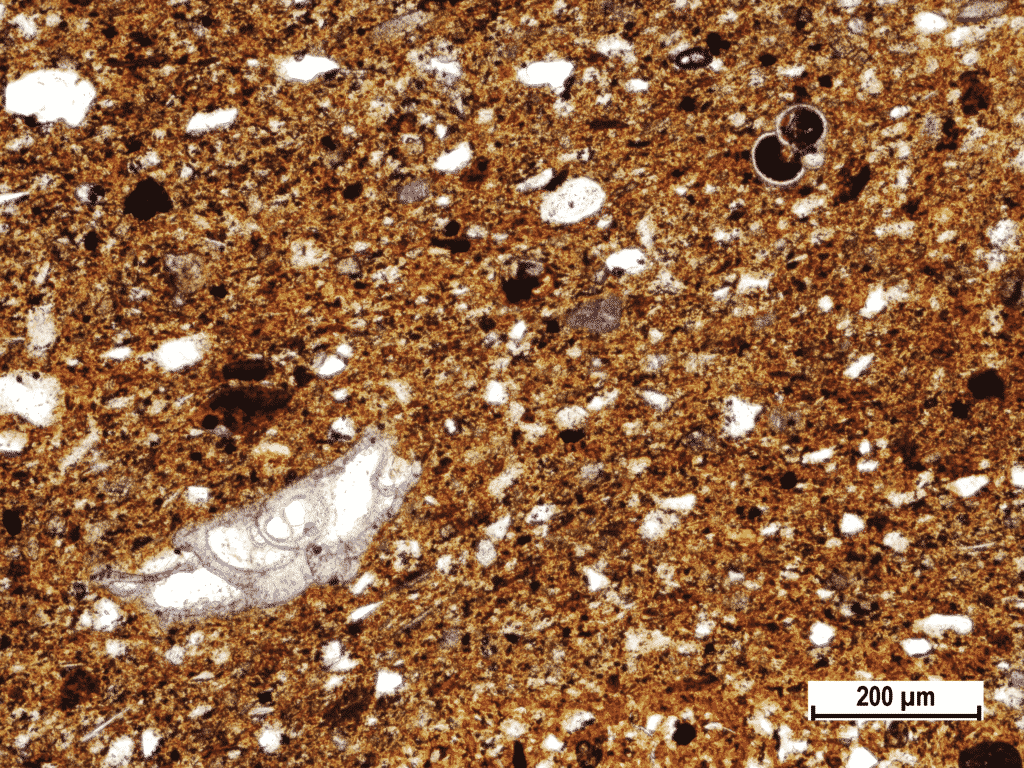
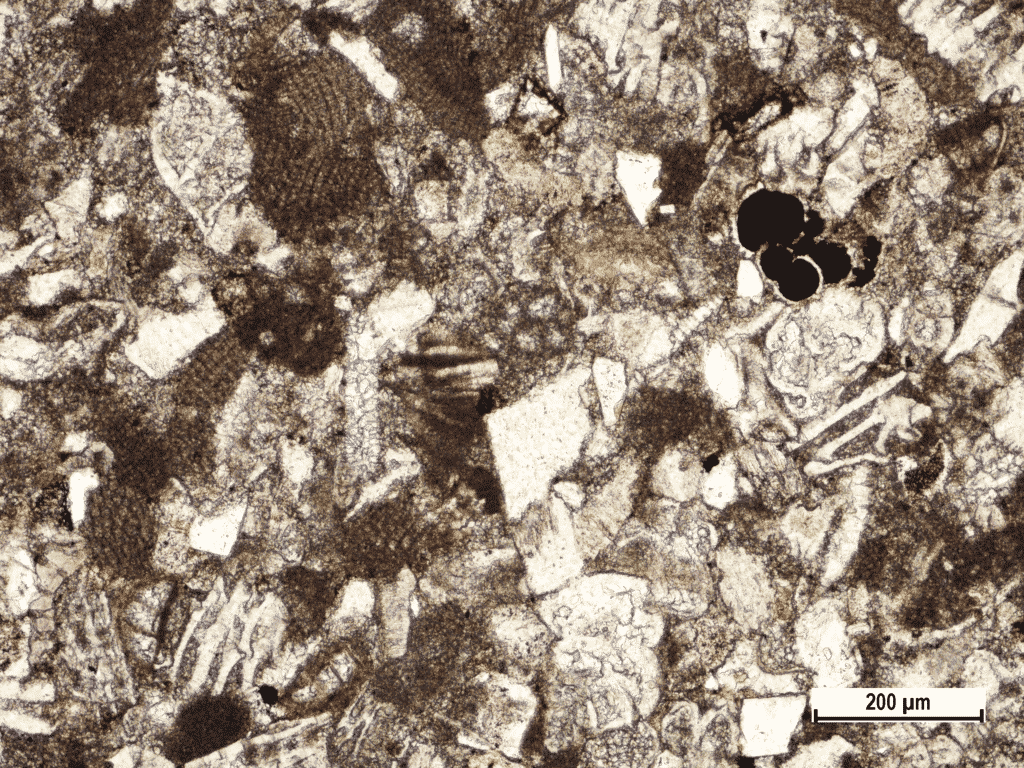
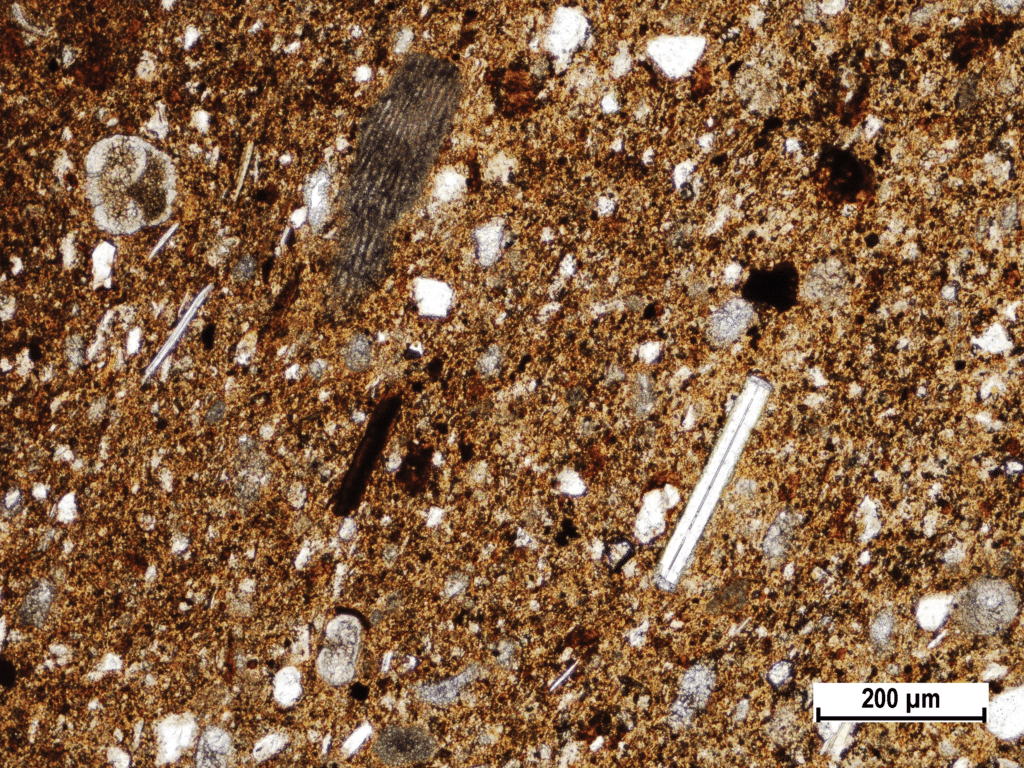
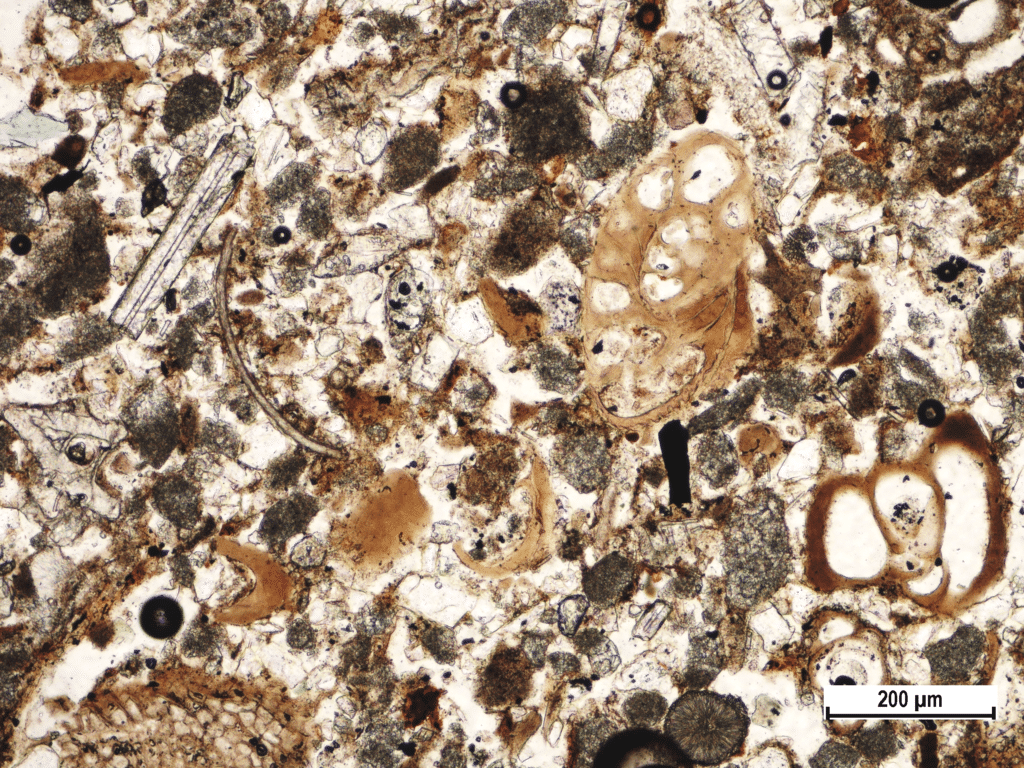
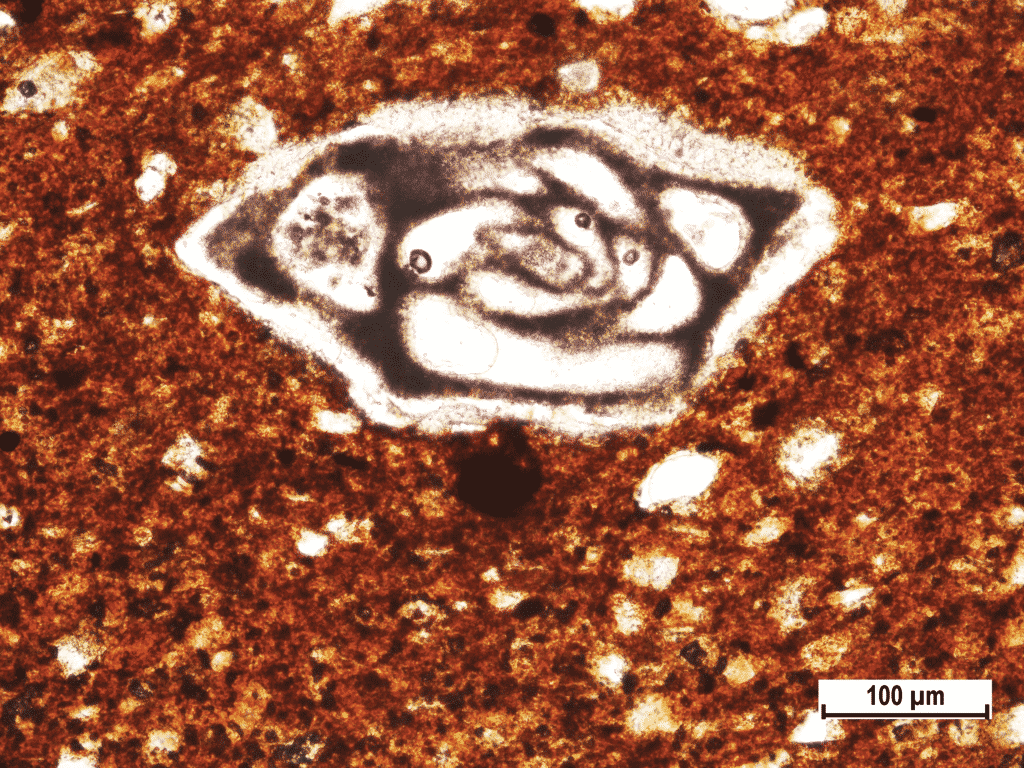
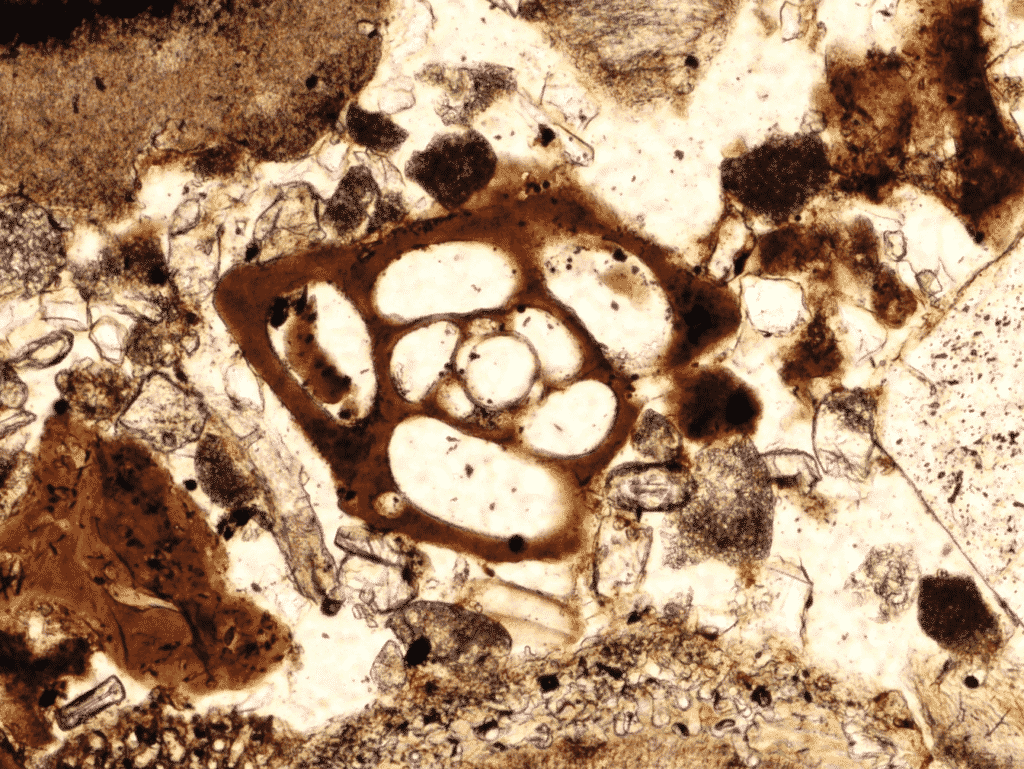
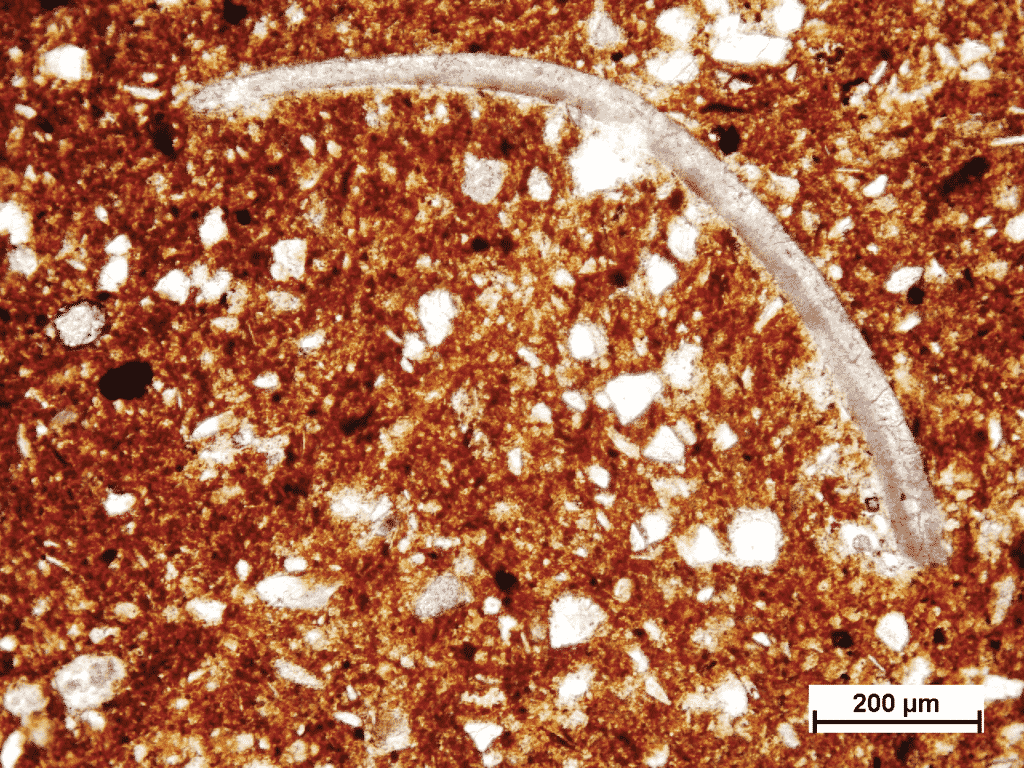
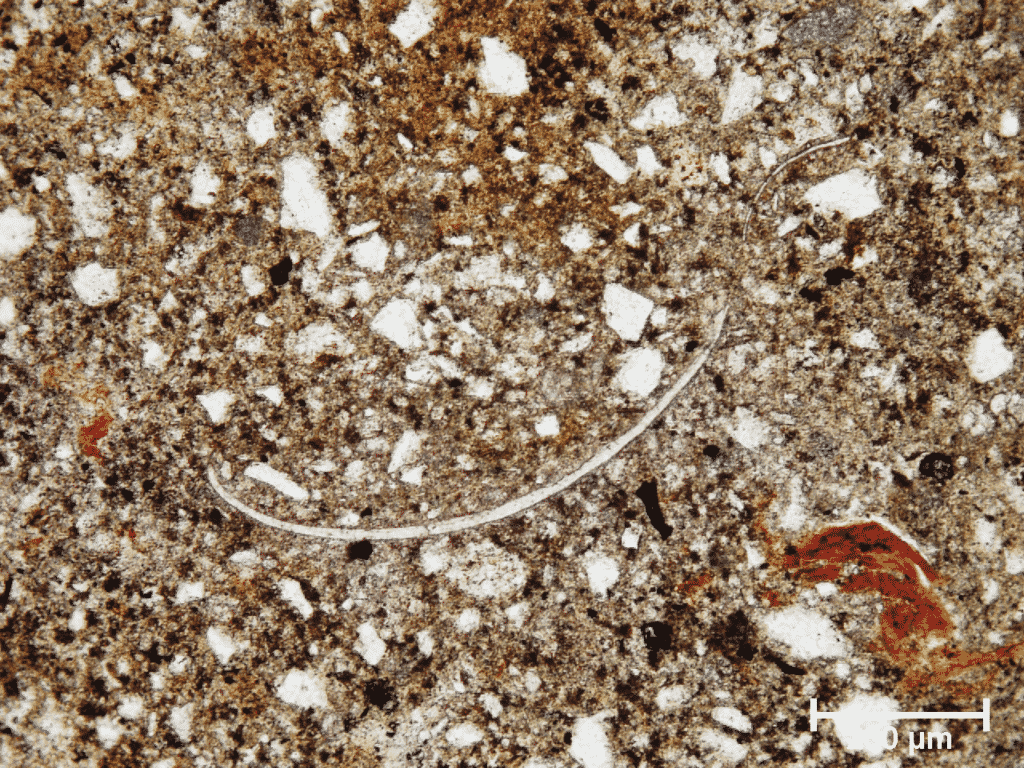
The different types of larger rounded composite rock inclusions found in the thin sections of amphorae have a different origin.
- The reddish siliciclastic free claystone is similar to pure TR, but very rare in the amphorae.
- The reddish siliciclastic rich claystone has a uniform appearance and is relatively frequent in the amphorae. It’s appearance is identical to the mixed TR. The microstructures of both field TR types and rock inclusions in amphorae are also identical (fig. 27, 28, 14).
- Certain other kinds of rock inclusions (claystones, sandstones, micritic limestones) which are also common in the amphorae have very variable features. All these rock inclusions are closely analogous to different FL rock types (fig. 29).
- The few larger inhomogeneous microsparitic-sparitic limestone fragments appearing in certain groups of amphorae are similar to the ML found in Istria.
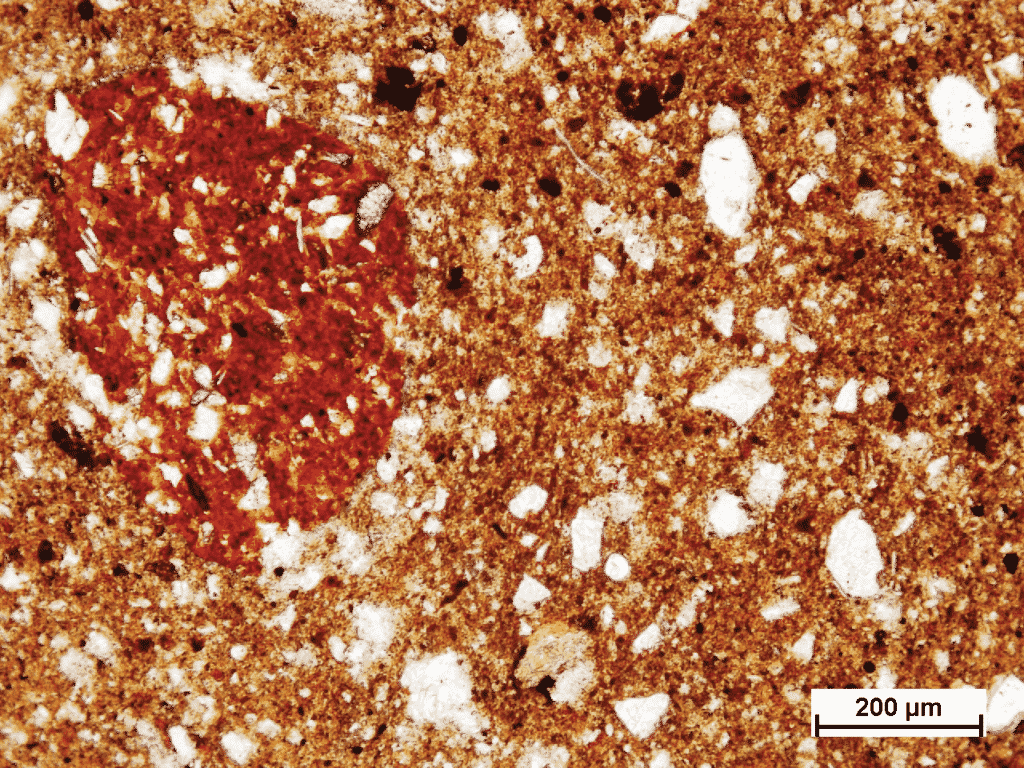
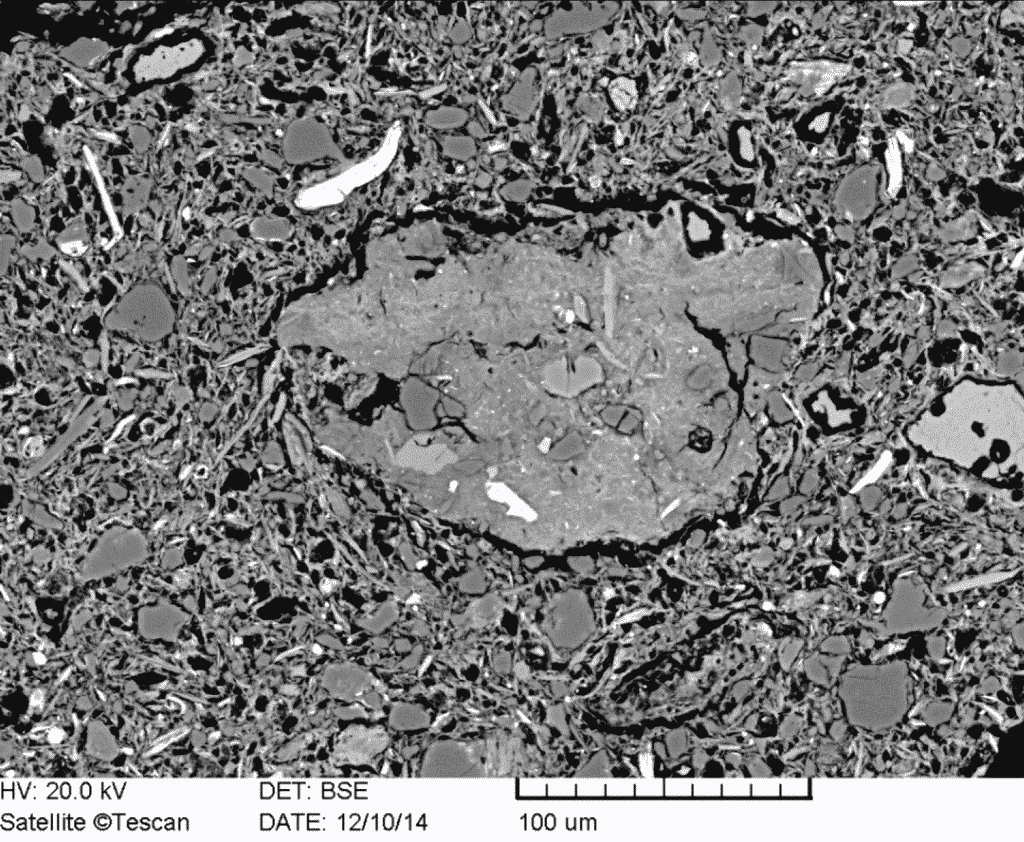
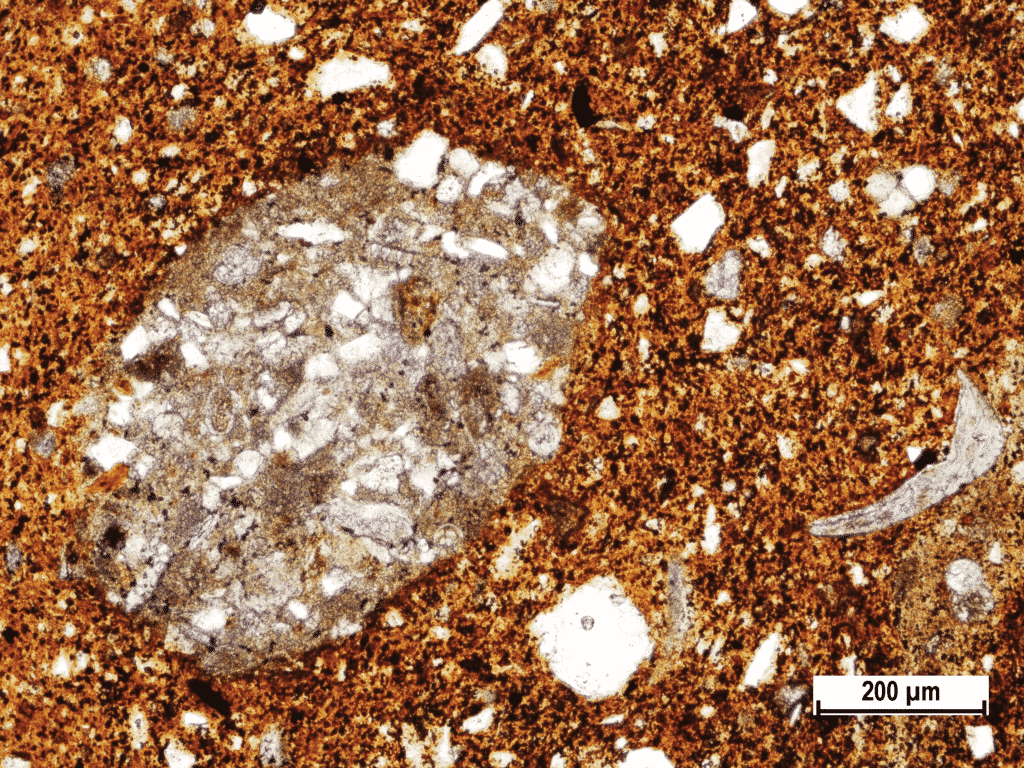
Petrographic conclusions
On the basis of the comparative evaluation presented above we can establish with great certainty that the fundamental components of the raw material of Fažana amphora originate from Istrian flysch. In addition, small quantities of the raw material could have been derived from terra rossa, recent marine originated fragments and Mesozoic limestones. In contrast to this, the material found in the field outcrops of the flysch or in debries fans and fluvial sediments rich in flysch components contain an inhomogeneous mixture of coarse, compact and massive grains of different flysch rock types. This material would be difficult to homogenize within a short time. In addition it would be very difficult to add those TR, MS and ML components separately, especially in the specific ratio observed in the amphorae; they are missing from the source rocks and appearing as rare but characteristic components in most of the amphorae. Consequently the raw material of Fažana amphorae must not have been excavated directly from continental inland flysch areas.
The most likely source of the main raw material of studied amphorae is a fine-grained clayey homogeneous sediment, which is rich in flysch-originated materials and contains few recent marine skeleton fragments, some terra rossa and very few Mesozoic limestone grains. The marine mud samples collected from the sea shores of Northern Istrian bays (e.g. the Piran and Koper Bays) show almost exactly the same composition and texture as it could be observed in the most common types of amphorae: some nonplastics, the microporous microtexture of the homogeneous groundmass, larger amounts of flysch originated fossils and siliciclastic components, some recent calcareous and opalic marine skeleton fragments, very few terra rossa grains and other types of flysch rock fragments.
In a group of amphorae, in such a fine-grained groundmass, larger sized grains of Mesozoic limestones, recent skeleton fragments and occasionally small amounts of terra rossa grains are jointly arranged in long and dense ribbon-like groups, giving them a hiatal texture. These features point to the possibility of the artificial tempering of North Istrian flysch based marine mud with a material similar to the one we described in the sandy samples collected from the coasts of South Istria, near Fažana.
Micromineralogy
The comparatively small sized, and usually very rare, accessory minerals are difficult to determine by optical petrography. Quantitative analysis of them is even harder because of the small area and volume of the samples we were able to study. A qualitative identification was made by electron microscope, and is more accurate, but the problem of the quantitative analysis is almost as prominent with this method.
This problem can be avoided by the use of micromineralogy, in the course of which the volume of studied sample is two orders of magnitude higher than in thin section petrography.
The investigation of accessory minerals may give more exact results concerning the identification and discrimination of used raw materials and determination of their mixing rate. Micromineralogical analysis, specifically heavy mineral research was made on the samples of Fažana amphorae and the two main possible raw materials, the flysch and the terra rossa. Details of the heavy mineral study were already presented by Obbágy et al. (2014), so only the most important results are presented in this work.
The dominant presence of pyrite, barite, opaque filled foraminiferas and few Cr-spinel among heavy components of amphorae clearly indicates the presence of larger amounts of flysch-originated material in the raw substance.
Several kinds of minerals found in amphorae could be detected in both the terra rossa and in the flysch, but their occurrence can differ in different sources. For instance, euhedral crystals are rather characteristic of terra rossa, while the broken crystals are characteristic of the flysch. In Fažana amphorae both minerals appear, but the ratio of the two possible main host rocks in the raw material of the amphorae could not be calculated from this.
Geochemical analysis
Both the petrographic and micromineralogic research refer only to the mineralogical composition of nonplastic components of the amphorae and the detrital components of field rock samples. Moreover, these methods only supply structural informations about the plastic material. The chemical analysis, in contrast with the petrography and micromineralogy, provides information about the amphorae as a whole (as well as about the plastic and nonplastic components) and about the rock composition of all of the field samples. It means that with the chemical analysis of an amphora we get incorporated information about all of the final raw material. Thus the results indicate a mixture of different components from very different origin (e.g. temper and clay base). Moreover, the chemical composition of studied material does not yield information about the mineral composition of the raw material. Thus the exact identification of different components of the raw materials of amphorae is impossible without petrographic investigations.
The aim of our geochemical investigation is to get more exact knowledge about the mixing ratio between the components of flysch and terra rossa in the final raw material of Fažana amphorae.
Major-, trace- and rare earth elements were measured on 17 amphorae, 4 flysch, 1 recent sediment from North Istria and 3 terra rossa samples (range values see in table 1) selected carefully on the base of previous detailed petrographic investigation. In the first step of the geochemical evaluation of data we have been looking for those elements, which are discriminative for the terra rossa and the flysch. With the help of monovariant diagrams we found that Si, Ti, Al and Ca among major element, the Sr, V, Y, Zr and Nb among trace elements and the La and Eu among rare earth elements are discriminative for the TR and the FL (fig. 30, 31, 32). With the help of these elements we can see which studied raw material stands closer to the amphorae from the point of view of a given element.
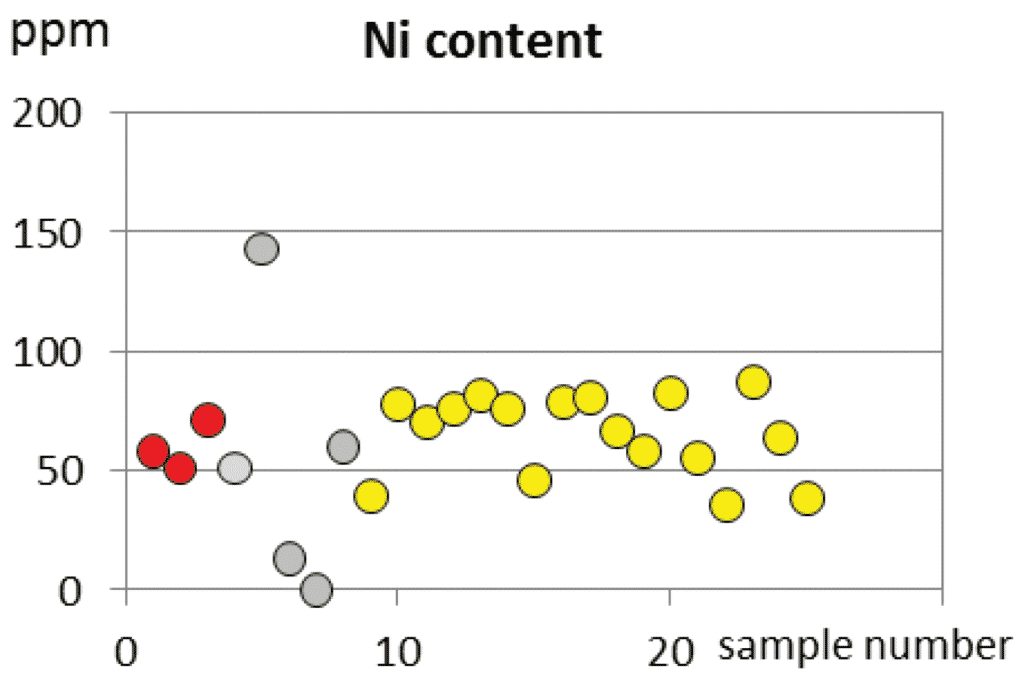
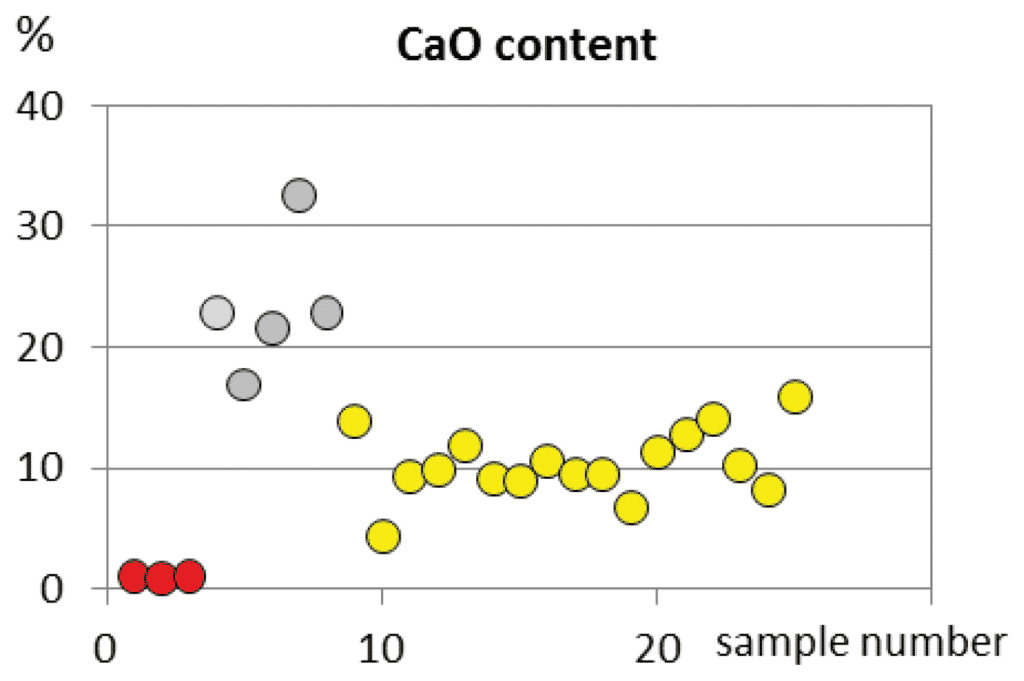
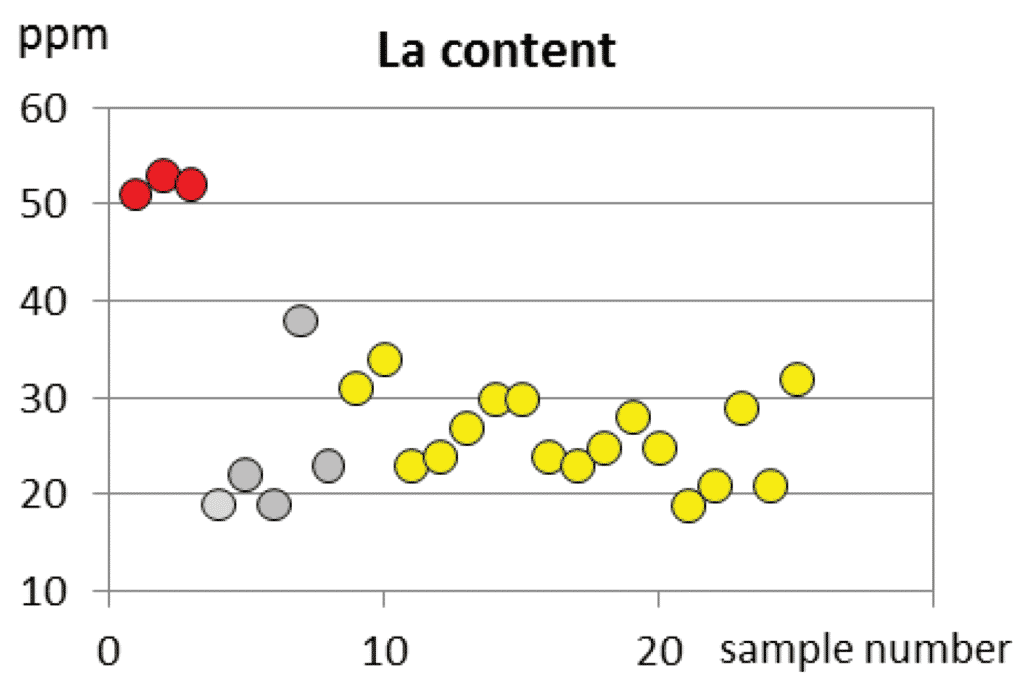
However, these results not only show the original chemical differences, they also show the influence of later processes (e.g. firing, leaching and burial) which might have caused chemical changes in studied materials. Consequently, if we want to know the original differences in chemical composition between the two main raw materials and want to compare this data with the original composition of the finally used raw material of the amphorae, we have to select the most immobile elements among the discriminatives. Among analysed elements Y, Zr and La are the most adequate immobile element (fig. 32). On bivariant diagrams of not only immobile elements (fig. 34), but of some less immobile elements as well (fig. 33) it is easy to notice that the spots of terra rossa are clustered in a very small area, in accordance with their unified appearance. In contrast, the spots of flysch rock types together with resedimented flysch sediment are more scattered, in accordance with their variable nature. It can also be observed that the original chemical composition of Fažana amphorae is very close to that of flysch and resedimented flysch data, and greatly differs from the composition of terra rossa (fig. 33, 34). On the basis of the geochemical evaluation of chemical data we can strengthen and complement the petrographic conclusions that the raw material for Fažana amphorae consisted dominantly of flysch originated material and it could contain only very few terra rossa. The chemical effect of other possible additional components (e.g. recent marine originated living being fragments) does not have visible significancy.
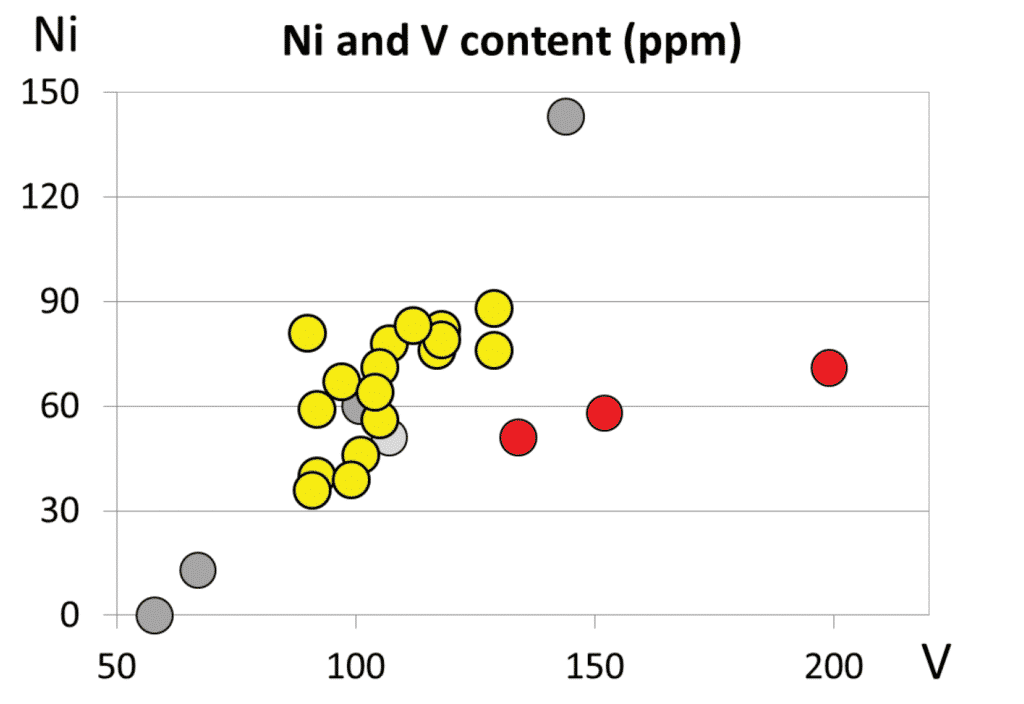
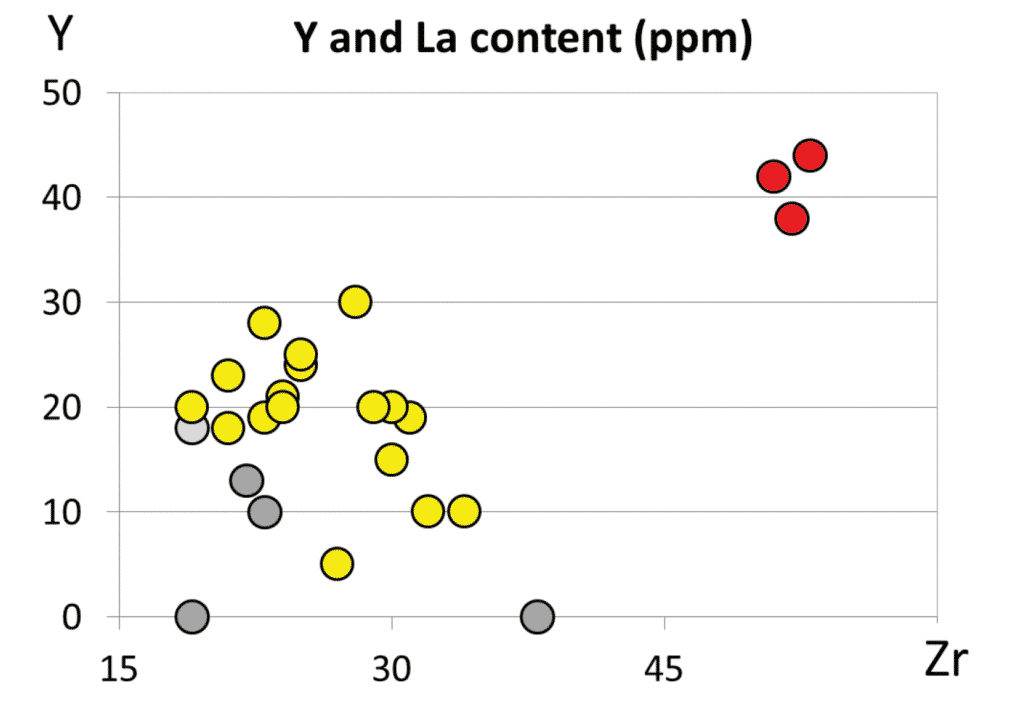
Summary of results
In previous11 research, mostly based on micromineralogical investigation, it was discovered that the main raw material of Dr 6B amphorae produced in Fažana was the terra rossa which was mixed with small amounts of recent marine originated material.
The main goal of our work was to determine more exactly the raw materials of Fažana amphorae and identify their sources. To plan the work we needed to know the nature of the material we were investigating and the appropriate methods needed for the investigation. The Fažana amphora – as any geological sample – have three main properties. The mineralogical composition, the texture and the chemical composition.
Except for the mineral composition of plastic material, we examined all these properties of Fažana amphorae and the comparative raw materials with four methods. The mineralogical composition of larger sized nonplastic materials and the general texture were investigated by petrographic microscope. The microstructure of plastic material were observed by electron microscope. The heavy mineral analysis was focused on small nonplastics, namely mainly on accessory minerals. Finally, the chemical composition of all the amphora samples, which reflects the chemical composition of the plastic component of the amphorae, was investigated through geochemical analysis. With this complex research, all the different components and each material of the amphorae could be investigated using the appropriate method.
The results of all these analyses on every characteristic components of Fažana amphorae showed that the main components of its raw material derived from the flysch rock series found in large area of the surface of North Istria. In the same way it was detected that only small amounts of terra rossa are present in the amphora’s raw material. The small amount of recent marine components in amphorae, as well as the characteristic differences between chemically identical flysch samples and North Istrian recent marine mud samples, could only be detected by petrography. Thanks to these observations, we were able to prove that the raw material of Fažana amphorae was excavated not in inland flysch areas but directly from shallow marine coastal muddy areas of the bays between Poreč and Triest (e.g. Piran or/and Koper Bays and/or the estuary of the Mirna river) in North Istria. For most of the studied amphorae this was the only raw material used. This could be due to the fact, that in these areas huge amount of mud, suitable for amphora production12 could be found and excavated easily just on the coast. After excavation, the flysch-based raw material could be directly loaded onto the ships and transported about 50-100 km by seaway from Novigrad or the Gulf of Trieste to Fažana. The recent marine sandy material consisting mostly of living beeng skeleton fragments and few terra rossa and Mesozoic limestone fragments found in certain groups of amphorae in small amount, could have gotten into the raw material most probably through artificial tempering on the location of amphora production, namely in Fažana, South Istria.



Acknowledgement
The authors are greatful to Mira Pavletić for her help in the field work for the collection of the samples from
the Brijuni islands. They would also like to thank Attila Kreiter, Dóra Kürthy,
Péter Véninger, Katalin Vanicsek, and Péter Pánczél for
their help and discussions. This work was supported by the Austrian Academy of
Science (FWF) P 23684. They thank the Ministarstvo Kulture Uprava Za Zaštitu
Kulturne Baštitu Konservatorski Odjel u Puli for the permission to collect and analyze samples in Istria.
References •••
- Bezeczky, T., ed (1987): Roman amphorae from the Amber Route in Western Pannonia, BAR Int. Ser. 386, Oxford.
- Bezeczky, T. (1998): The Laecanius Amphorae Stamps and the Villas of Brijuni, Österreichische Akademie der Wissenschaften, Denkschriften 261, Wien.
- Bezeczky, T. (2014): “The Laecanius Amphorae”, in: Roman Pottery and Glass Manufactures; Production and trade in the Adriatic region. Experimental archaeology, Proceedings of the 2nd International Archaeological Colloquium, Crikvenica (Croatia) 28 – 29 October 2011, Crikvenica, 241-257.
- Bezeczky, T. and Mange, M. A. (2009): “New petrographic data of the Laecanius and Imperial workshop in Fažana (Istria, Croatia)”, in: Biró et al., ed. 2009, 247-254.
- Biró, K. T., Szilágyi, V. and Kreiter, A., ed. (2009): Vessels: inside and outside, Proceedings of the Conference EMAC ’07, 9th European Meeting on Ancient Ceramics, 24-27 October 2007, Budapest.
- Józsa, S. and Szakmány, G. (1987): “Petrology”, in : Bezeczky, ed. 1987, 103-124.
- Mange, M. A. and Bezeczky, T. (2006): “Petrography and Provenance of Laecanius Amphorae from Istria, Northern Adriatic Region, Croatia”, Geoarchaeology, 21, 429-460.
- Mange, M. A. and Bezeczky, T. (2007): “The provenance of paste and temper in Roman amphorae from the Istrian Peninsula, Croatia”, in : Mange & Wright, ed. 2007, 1007-1033.
- Mange, M. A. and Wright, D. T., ed. (2007): Heavy minerals in use, Developments in Sedimentology 58, Elsevier.
- Matijašić, R. (1988): Ageri antičkih kolonija Pola i Parentium, Latina et Graeca VI, Zagreb.
- Obbágy, G., Józsa, S., Szakmány, Gy., Bendő, Z. and Bezeczky, T. (2014): “Isztriai amforák nyersanyagának nehézásvány-vizsgálati eredményei (Results of heavy mineral research of the raw materials of Istrian amphorae)”, Gesta, 13, 39-58. (in Hungarian).
- Paci, G., ed. (1998): Epigrafia romana in area adriatica. IXe Rencontre franco-italienne sur l’épigraphie du monde romain, Macerata 10-11 Nov. 1995, Pisa-Rom.
- Starac, A. (2010): Dragonera: dva bisera. Dragonera: two pearls, Pula.
- Tassaux, F. (1982): “Laecanii, Recherches sur une famille sénatoriale d’Istrie”, MEFRA, 94, 227-269.
- Tassaux, F. (1998): “Apports récents de l’épigraphie à l’histoire économique et sociale de Brioni”, in: Paci, ed. 1998, 77-99.
- Tassaux, F. (2001): “Production et diffusion des amphores à huile istriennes”, AAAd, 46, 501-543.
- Véninger, P. (2016): Flis és terra rossa fazekas szemmel. Korongozhatósági vizsgálat: milyen agyag lehet alkalmas nagyméretű római amphorák készítésére? (Flysch and terra rossa from the potter’s point of view. Studying by the potter’s wheel: what kind of clay might have been used for large-scale roman amphora production?), Archaeometry Workshop 2016/XIII./2 (in Hungarian with English abstract).
- Weiszburg, T. and Papp, G. (1987): “X-ray powder diffraction analyses”, in: Bezeczky, ed. 1987, 128-133.
- Živkovic, S. and Bogner, D. (2006): “Coprolite status of Coptocampylodon lineolatus Elliott 1963 (incertae sedis) from Middle Eocene deep-sea sediments of Istria (Croatia)” Micropaleontology, 52 (4), 371-379.
Notes •••
- Plin., Nat., 15.9; Martial 12.63; Pausanias 10.32.19; Cassiodorus, Variae, 12.22-26.
- Tassaux 1982; Tassaux 1998; Tassaux 2001; Bezeczky 1998; Bezeczky 2014.
- See the above contribution of Davor Bulić and Ida Koncani Uhač.
- Starac 2010.
- Matijašić 2001, 342-344.
- Bezeczky 1987, Józsa & Szakmány 1987.
- Weiszburg & Papp 1987.
- Mange & Bezeczky 2006, 2007; Bezeczky & Mange 2009.
- Described in Bezeczky 1998.
- Bezeczky 1998.
- Mange & Bezeczky 2006, 2007; Bezeczky & Mange 2009.
- Véninger 2016.


